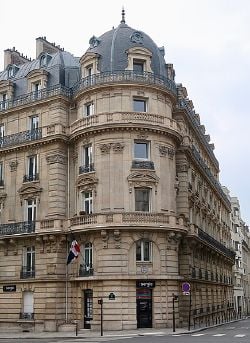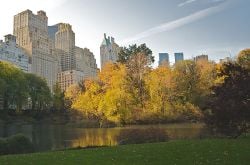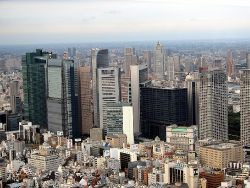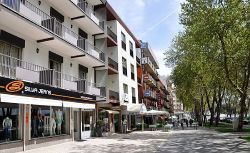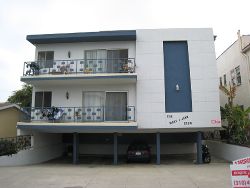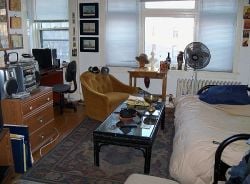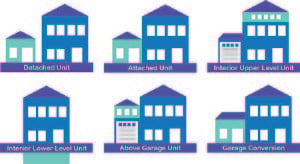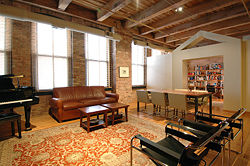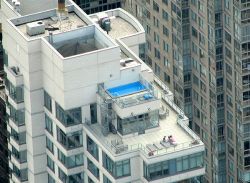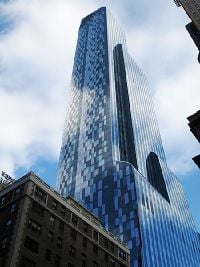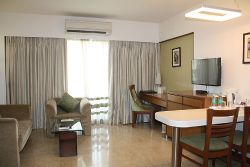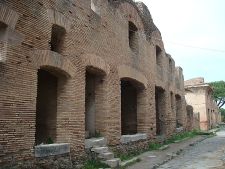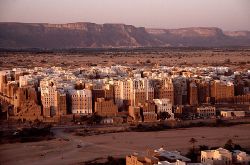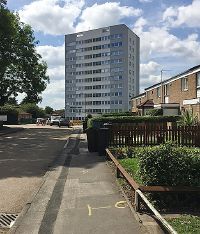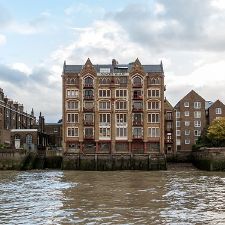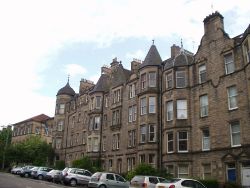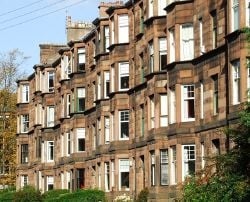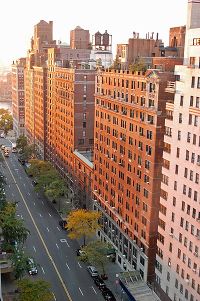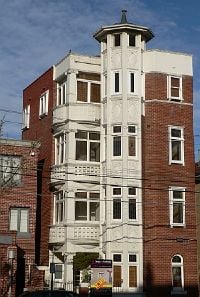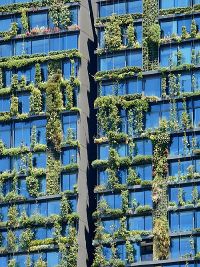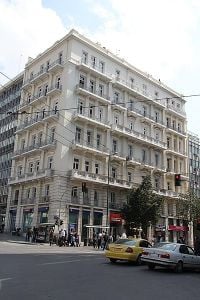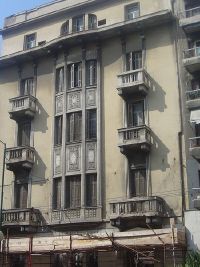Difference between revisions of "Apartment" - New World Encyclopedia
Rosie Tanabe (talk | contribs) |
|||
| (140 intermediate revisions by one other user not shown) | |||
| Line 1: | Line 1: | ||
| − | + | {{Images OK}}{{Submitted}}{{Approved}}{{Copyedited}} | |
| + | [[File:45 rue de Courcelles, Paris 8e 2.jpg|thumb|right|250px|Apartments on Rue de Monceau, in Paris]] | ||
| − | + | An '''apartment''' ([[American English]]), or '''flat''' ([[British English]]), is a self-contained [[housing unit]] (a type of residential [[real estate]]) that occupies only part of a building, generally on a single story. Apartments range in size, features, and occupation, from low-income families or singles living in cramped quarters in the inner cities, to the luxury penthouses and serviced apartment buildings affordable only by the wealthy. The [[housing tenure]] of apartments also varies considerably, from large-scale [[public housing]], to tenants renting from a private landlord, to [[owner occupancy]] within what is legally a [[condominium]]. | |
| − | + | {{toc}} | |
| − | + | Despite these disparities, the common feature of apartment construction is the maximizing of land for living space. This building strategy has been utilized the world over since ancient times, and continues to find new and creative expressions as human society develops. | |
| − | |||
| − | |||
| − | |||
| − | An '''apartment''' ([[American English]]), or '''flat''' ([[British | ||
==Terminology== | ==Terminology== | ||
| − | + | [[File:Central Park during Autumn, NYC.jpg|thumb|right|250px|Apartments facing [[Central Park]] in Midtown [[Manhattan]], [[New York City]]]] | |
| − | + | [[File:Shiodome Area from Tokyo Tower.jpg|thumb|right|250px|Diverse types of apartments in [[Minato, Tokyo]], Japan]] | |
| + | [[File:Calle de Alcalá (Madrid) 16.jpg|thumbnail|250px|Apartments in [[Madrid]], Spain]] | ||
| − | + | Both "apartment" and "flat" refer to a self-contained residential unit with its own front door, [[kitchen]], [[toilet]], and [[bathroom]]. | |
| − | In | + | The term "apartment" is favored in North America. In [[British English]] the usual word is "flat," which is used commonly, but not exclusively, for an apartment on a single level (hence a "flat" apartment). In Scotland, the building is called a block of flats or, if it is a traditional sandstone building, a "[[tenement]]," a term which has a negative connotation elsewhere. In the UK the term "apartment" is used by property developers to denote expensive flats in exclusive and expensive residential areas in, for example, parts of [[London]] such as [[Belgravia]] and [[Hampstead]]. |
| − | + | In [[American English]], the distinction between rental apartments and "[[condominium]]s" is that while rental buildings are owned by a single entity and rented out to many, condominiums are owned individually and their owners pay a monthly or yearly fee for building upkeep. Condominiums are often leased by their owner as rental apartments. | |
| − | + | A third alternative, the [[Housing cooperative|cooperative apartment]] building (or "co-op"), acts as a corporation with all of the tenants as shareholders of the building. Tenants in cooperative buildings do not own their apartment, but instead own a proportional number of shares of the entire cooperative. As in condominiums, cooperators pay a monthly fee for building upkeep. Co-ops are common in cities such as New York, and have gained some popularity in other larger urban areas in the U.S. | |
| − | [[ | ||
| − | |||
| − | + | In [[Australia]] and [[New Zealand]], the traditionally used term is "flat" (although this also applies to any rental property), and more recently the terms "unit" or "apartment" are also used. In Australia, the terms "unit", "flat," and "apartment" are largely used interchangeably. Newer high-rise buildings are more often marketed as "apartments," as the term "flats" carries colloquial connotations. | |
| − | [[ | + | In some countries, the word "[[Unit (housing)|unit]]" is a more general term referring to both apartments and rental business [[Suite (address)|suite]]s. The word "unit" is generally used only in the context of a specific building, for example, "This building has three units." |
| − | In | + | In [[Japan]]ese English [[loanword]]s (''[[Wasei-eigo]]''), the term "apartment" (''apaato'') is used for lower-income housing and "mansion" (''manshon'') is used for high-end apartments; but both terms refer to what English-speakers regard as an apartment. This use of the term "mansion" has a parallel with [[British English]]'s "mansion block," a term denoting prestigious apartment buildings from the [[Victorian era|Victorian]] and [[Edwardian era|Edwardian]] eras, which usually feature an ornate facade and large, high-ceilinged flats with period features. |
| − | In | + | ==Ownership== |
| + | In the United States, some apartment-dwellers own their units, either as a [[housing cooperative]], in which the residents own shares of a corporation that owns the building or development; or in a [[condominium]], whose residents own their apartments and share ownership of the public spaces. | ||
| − | + | In England and Wales, some flat owners own shares in the company that owns the [[Fee simple|freehold]] of the building as well as holding the flat under a lease. This arrangement is commonly known as a "share of freehold" flat. The freehold company has the right to collect annual ground rents from each of the flat owners in the building. The freeholder can also develop or sell the building, subject to the usual planning and restrictions that might apply. This situation does not happen in Scotland, where long leasehold of residential property was formerly unusual, and is now impossible.<ref>[https://www.legislation.gov.uk/asp/2012/9/contents/enacted Long Leases (Scotland) Act 2012] ''UK Legislation''. Retrieved June 14, 2021.</ref> | |
| − | |||
| − | == | + | ==Apartment buildings== |
| − | [[File:English Bay Vancouver.jpg|thumb|right|[[High-rise building]]s in the [[English Bay (Vancouver)|English Bay]] area of [[Vancouver]], [[British Columbia]], Canada]] | + | [[File:English Bay Vancouver.jpg|thumb|right|250px|[[High-rise building]]s in the [[English Bay (Vancouver)|English Bay]] area of [[Vancouver]], [[British Columbia]], Canada]] |
| − | [[ | + | {{Main|Apartment building}} |
| + | [[Apartment building]]s are [[multi-story]] [[building]]s where three or more residences are contained within one structure. Such a building may be called an apartment building, apartment complex, flat complex, block of flats, tower block, high-rise or, occasionally, mansion block (in British English), especially if it consists of many apartments for rent. A high-rise apartment building is commonly referred to as a residential tower, apartment tower, or block of flats in Australia. | ||
| − | + | ===High-rise=== | |
| + | A [[high-rise building]] is defined by its height differently in various [[jurisdiction]]s. It may be only residential, in which case it might also be called a tower block, or it might include other functions such as hotels, offices, or shops. There is no clear difference between a tower block and a [[skyscraper]]. Historically, the term "skyscraper" first referred to buildings with between 10 and 20 stories when these types of buildings began to be constructed in the 1880s. Today, skyscrapers are much taller, and the height criterion has risen to 150 meters (492 feet), while at least half of their floor space has to be habitable.<ref>Fred Mills, [https://www.theb1m.com/article/what-makes-a-building-a-skyscraper-2020 What makes a building a skyscraper? The answer is more complicated than you might imagine] ''The B1M'', July 20, 2020. Retrieved June 15, 2021.</ref> High-rise buildings became possible with the invention of the [[elevator]] (lift) and cheaper, more abundant building materials. Their [[structural system]] usually is made of [[reinforced concrete]] and [[steel]]. | ||
| − | A [[ | + | ===Low-rise and mid-rise=== |
| + | [[File:Fatima 0549 (19531851070).jpg|thumb|left|250px|A [[low-rise building]] of flats above shops in [[Fátima, Portugal]]]] | ||
| + | Low-rise and mid-rise buildings have fewer stories than high-rise, but the limits are not always clear. [[Emporis]] defines a low-rise as "an enclosed structure whose architectural height is below 35 meters, and which is divided at regular intervals into occupiable levels."<ref>[https://www.emporis.com/building/standard/15/low-rise-building low-rise building (ESN 49213)] ''Emporis Standards''. Retrieved June 15, 2021.</ref> | ||
| − | + | ===Small buildings=== | |
| + | [[File:Dingbat MaryJane.jpg|thumb|right|250px|A Dingbat building with styled balconies]] | ||
| + | In addition to the larger building types with multiple stories, a variety of styles of smaller buildings also serve as apartments. | ||
| − | + | A "dingbat" is a type of formulaic [[apartment building]] that flourished in the [[Sun Belt]] region of the [[United States]] in the 1950s and 1960s, a [[Vernacular architecture|vernacular]] variation of [[shoebox style (architecture)|shoebox style]] "stucco boxes." Dingbats are boxy, two or three-story apartment houses with overhangs sheltering street-front parking.<ref> Leonard Pitt and Dale Pitt, ''Los Angeles A to Z: An Encyclopedia of the City and County'' (University of California Press, 2000, ISBN 978-0520205307).</ref> Mainly found in [[Southern California]], but also in [[Arizona]], [[Florida]], [[Hawaii]], [[Nevada]] and [[Vancouver]], dingbats are known for their downmarket status and inexpensive rents. | |
| − | [[ | ||
| − | |||
| − | + | "[[Duplex (building)|Duplex]]" refers to two separate units with a [[party wall|common demising wall]] or floor-ceiling assembly. The description can be different depending on the part of the US, but generally has two to four dwellings with a door for each and usually two front doors close together but separate. "Duplex" indicates the number of units, not the number of floors, as in some areas of the country they are often only one story. Buildings that have a third story are known as triplexes, or triple-deckers. | |
| − | In | + | In the United States, regional forms have developed, see [[vernacular architecture]]. In [[Milwaukee, Wisconsin|Milwaukee]], a [[Polish flat]] or "raised cottage" is an existing small house that has been lifted up to accommodate the creation of a basement floor housing a separate apartment, then set down again, thus becoming a modest pair of dwellings.<ref>Sally McMurry and Annmarie Adams (eds.), ''People, Power, Places'' (University of Tennessee Press, 2000, ISBN 978-1572330757).</ref> |
| − | [[ | + | [[Image:CambridgeTripleDecker.jpg|right|thumb|250px|Three decker apartment building in Cambridge, [[Massachusetts]] built in 1916 ]] |
| + | A certain type of three-story [[apartment building]] is often called a "three-decker" or "triple-decker" in the United States. These buildings are typical of [[light-frame construction|light-framed, wood construction]], where each floor usually consists of a single apartment, and frequently originally extended families lived in two or all three floors. Both stand-alone and [[semi-detached]] versions are common. | ||
| − | + | During the late nineteenth and early twentieth centuries, tens of thousands of triple-deckers were constructed, mostly in [[New England]], as an economical means of housing the thousands of newly-arrived immigrant workers who filled the factories of the area. The economics of the triple-decker are simple: the cost of the land, basement and roof are spread among three or six apartments, which typically have identical floor plans.<ref> Bruce Irving, [https://www.thisoldhouse.com/jamaica-plain-house/21017436/the-jamaica-plain-house The Jamaica Plain House] ''This Old House''. Retrieved June 16, 2021. </ref> The triple-decker apartment house was seen as an alternative to the [[row house|row-housing]] built in other cities of [[Northeastern United States]] during this period, such as in [[New York City]], [[Boston]], [[Philadelphia]], [[Baltimore]], and [[Washington, D.C.]] | |
| − | In | + | In the United Kingdom the term ''duplex'' is rare. Buildings containing two dwellings with a common vertical wall are instead known as "semi-detached," or colloquially a "semi." This form of construction is very common, and built as such rather than a later conversion. |
==Types and characteristics== | ==Types and characteristics== | ||
===Studio apartment=== | ===Studio apartment=== | ||
| − | [[File: | + | [[File:Studio Apartment Minneapolis 1.jpg|thumb|right|250px|The main room of a studio apartment in [[Minneapolis]], Minnesota, United States. The [[sofabed]] is to the right and a small [[alcove (architecture)|alcove]] on the left. Not shown are the small kitchen and bathroom.]] |
| − | |||
| − | |||
| − | |||
| − | + | The smallest self-contained apartments are referred to as studio, efficiency, or bachelor apartments in the US and Canada, or studio flat in the UK. These units usually consist of a large single main room which acts as the living room, dining room, and bedroom combined and usually also includes kitchen facilities, with a separate bathroom. | |
| − | |||
| − | A | + | A variation, sometimes called an "alcove studio," may have a very small separate area; this wing or nook is off the main area, and can be used for dining or sleeping. The apartment's kitchen facilities may be located either in the central room or in a small separate area. The bathroom is usually in its own smaller room, while the toilet can be separated. |
| + | A studio apartment differs from a [[bedsit|bedsitter]] in the United Kingdom or [[single room occupancy]] (SRO) unit in the United States, in that an SRO does not usually contain a kitchen or bathroom. Bathroom facilities are shared with multiple units on the hall. In the UK, a bedsit, without cooking facilities and with a shared bathroom, is not self-contained and so is not considered an apartment or flat; it forms part of what the UK government calls a [[House in multiple occupation]].<ref>[https://www.gov.uk/private-renting/houses-in-multiple-occupation Private renting: Houses in multiple occupation] ''GOV.UK''. Retrieved June 14, 2021.</ref> | ||
| − | + | ===Garden apartment (US)=== | |
| − | + | A garden apartment in [[American English]] is defined as "a multiple-unit low-rise dwelling having considerable lawn or garden space."<ref>[https://www.merriam-webster.com/dictionary/garden%20apartment Garden apartment] ''Merriam-Webster Dictionary''. Retrieved June 15, 2021.</ref> A garden apartment shares some characteristics with a [[townhouse]]: Each apartment has its own building entrance, or shares that entrance via a staircase and lobby that adjoins other units immediately above and/or below it. However, unlike a townhouse, each apartment occupies only one level. | |
| − | |||
| − | + | Garden apartment buildings are often arranged around courtyards that are open at one end, and the interior grounds are often landscaped. These buildings are almost never more than three stories high, since they typically lack [[elevator]]s. However, the first "garden apartment" buildings in New York, built in the early 1900s, were constructed five stories high.<ref>Barry Popik,[https://www.barrypopik.com/index.php/new_york_city/entry/garden_apartments/ Garden Apartment] April 4, 2005. Retrieved June 15, 2021.</ref> Some garden apartment buildings place a one-car garage under each apartment. | |
| − | |||
| − | |||
| − | |||
===Garden flat (UK)=== | ===Garden flat (UK)=== | ||
| − | [[File:Streets of Bayswater.jpg|thumb|[[Georgian architecture|Georgian]] terraced [[townhouse (Great Britain)|townhouses]] in [[London]], England. The black railings enclose the basement areas, which in the twentieth century were converted to garden flats.]] | + | [[File:Streets of Bayswater.jpg|thumb|250px|[[Georgian architecture|Georgian]] terraced [[townhouse (Great Britain)|townhouses]] in [[London]], England. The black railings enclose the basement areas, which in the twentieth century were converted to garden flats.]] |
| − | + | A "garden flat" in [[British English]] is defined as "a flat with direct access to a garden: typically, a garden flat consists of basement accommodation in prewar property, but some are in purpose-built blocks in urban areas."<ref>[https://www.dictionary.com/browse/garden-flat Garden Flat] ''Dictionary.com''. Retrieved June 15, 2021.</ref> The large [[townhouse (Great Britain)|Georgian or Victorian townhouse]] was built with an excavated subterranean space around its front known as [[Area (architecture)|an area]], often surrounded by cast iron railings. This lowest floor housed the kitchen, the main place of work for the servants, with a "tradesman's entrance" via the area stairs. This "lower ground floor," or basement, proved ideal for conversion to self-contained "garden flats." "Garden flat" can serve simply as a euphemism for a basement apartment. | |
===Basement apartment=== | ===Basement apartment=== | ||
| + | A "basement apartment" is an apartment located below [[street]] level, underneath another structure—usually an [[apartment building]], but possibly a [[house]] or a business. Cities in North America are beginning to recognize these units as a vital source of housing in urban areas and legally define them as an [[Accessory Dwelling Unit]] or "ADU." | ||
| − | + | [[Renting|Rent]] in basement apartments is usually much lower than it is in above-ground units, due to a number of deficiencies common to basement apartments. The apartments are usually cramped, and tend to be noisy, both from uninsulated building noises and from traffic on the adjacent street.<ref name="Chen">David W. Chen, [https://www.nytimes.com/2004/02/25/nyregion/be-it-ever-so-low-the-basement-is-often-home.html Be It Ever So Low, the Basement Is Often Home] ''The New York Times'', February 25, 2004. Retrieved June 15, 2021.</ref> They are also particularly vulnerable to [[burglary]], especially those with windows at sidewalk level. In some instances, residential use of below-ground space is illegal, but it is done in order for the building owner to generate extra income. Many renters accept the situation as a way to save money.<ref name="Chen"/> | |
| − | |||
| − | |||
| − | [[Renting|Rent]] in basement apartments is usually much lower than it is in above-ground units, due to a number of deficiencies common to basement apartments. The apartments are usually cramped, and tend to be noisy, both from uninsulated building noises and from traffic on the adjacent street.<ref name="Chen">David W. Chen, [https:// | ||
| − | |||
| − | |||
===Secondary suite=== | ===Secondary suite=== | ||
| − | + | [[File:Accessory Dwelling Unit (ADU) Types.jpg|thumb|300px|Common types of secondary suites]] | |
| − | + | Secondary suites, or "accessory dwelling units" (ADUs), or "in-law apartments," are self-contained apartments, cottages, or small residential units, that are located on a property that has a separate main, single-family home, duplex, or other residential unit. In [[British English]] the term "annex" or "granny annex" is used instead. | |
| − | |||
| − | |||
| − | |||
| − | |||
| − | |||
| − | |||
| − | |||
| − | |||
| − | |||
| − | |||
| − | |||
| − | |||
| − | |||
| − | |||
| − | |||
| − | |||
| − | |||
| − | |||
| − | + | The "accessory dwelling unit" may be attached to the principal dwelling or an entirely separate unit, located above a garage or in the backyard on the same property. | |
| − | |||
| − | |||
| − | "[[ | + | A secondary suite is considered "secondary" or "accessory" to the [[primary residence]] on the parcel. It normally has its own entrance, kitchen, bathroom and living area. There are three types of accessory units: interior, interior with modification, and detached. Examples of these accessory units include: |
| − | + | * A suite above a rear detached garage (a "[[garage apartment]]"), | |
| + | * A suite above the main floor of a single-detached dwelling, | ||
| + | * A suite below the main floor of a single-detached dwelling (a "[[basement suite]]"). | ||
| + | * A suite attached to a single-detached dwelling at grade, or | ||
| + | * A suite detached from the principal dwelling (a "garden suite" or "[[Guest house (secondary suite)|guesthouse]]"). | ||
| − | + | Reasons for wanting to add a secondary suite to a property may be to receive additional income, provide social and personal support to a family member, or obtain greater security. | |
| − | |||
| − | |||
===Loft apartment=== | ===Loft apartment=== | ||
| − | [[File:400SGreenLoft.jpg|thumb|The interior of a loft conversion in Chicago]] | + | [[File:400SGreenLoft.jpg|thumb|250px|The interior of a loft conversion in Chicago]] |
| − | |||
| − | |||
| − | + | Loft apartments developed in North America during the middle of the twentieth century. The term initially described a living space created within a former industrial building, usually nineteenth century. These large apartments found favor with artists and musicians wanting accommodation in large cities, such as [[New York City]]. | |
| − | + | These loft apartments were usually located in former high rise warehouses and factories left vacant after town planning rules and economic conditions in the mid twentieth century changed. The resulting apartments created a new bohemian lifestyle. They are arranged in a different way from most urban living spaces, often including workshops and art studio spaces. As the supply of old buildings of a suitable nature dried up, developers responded by constructing new buildings in the same aesthetic. | |
===Penthouse=== | ===Penthouse=== | ||
| − | [[ | + | [[Image:Penthouseupperwest.jpg|thumb|right|200px|Penthouse apartment at the top of a building on the [[Upper West Side]], [[New York City]].]] |
| − | [[File: | + | [[File:Rooftop pool NYC.jpg|thumb|right|250px|A [[Manhattan]] penthouse with swimming pool, as viewed from the [[Empire State Building]] observation deck]] |
| − | + | The term "penthouse," derived from the [[Old French]] {{lang|fr|apentis}}, meaning "attached building" or "appendage" with the modern spelling coming from a sixteenth century [[folk etymology]] influence by the French {{lang|fr|pente}} ("slope") and English "house,"<ref>[https://www.etymonline.com/word/penthouse penthouse] ''Etymology online''. Retrieved June 16, 2021.</ref> refers to an apartment or unit on the highest floor of an [[apartment building]], [[condominium]], or [[hotel]]. A penthouse apartment/condominium may also provide occupants with private access to the roof space above the apartment. The term "penthouse" originally referred, and sometimes still does refer, to a separate smaller "house" that was constructed on the roof of an apartment building. | |
| − | + | Penthouse apartments have not only the advantages of a regular apartment, such as security and convenient location, but also many of those of a house, such as size and design. | |
| − | Penthouse apartments have not only the advantages of a regular apartment such as security and convenient location but also many of those of a house such as size and design. | ||
| − | Similar to other city apartments, penthouses are usually located in the heart of [[urban centers]] yet offer a sense of being situated far away from or above noisy and crowded urban life. Such locations provide easy access to [[ | + | Similar to other city apartments, penthouses are usually located in the heart of [[urban centers]] yet offer a sense of being situated far away from or above noisy and crowded urban life. Such locations provide easy access to [[hotel]]s, [[restaurant]]s, [[Shopping mall|mall]]s, and [[school]]s. On the basis of their sometimes larger size, penthouses also generally overcome the issue of small space in regular apartments. |
| − | |||
| − | |||
| − | Features not found in the majority of apartments in the building may include a private entrance or [[elevator]], or higher/vaulted ceilings | + | Penthouses are typically differentiated from other apartments by luxurious [[Amenity|amenities]] such as high-end [[Home appliance|appliances]], finest materials fitting, luxurious [[flooring]] system, and more. Features not found in the majority of apartments in the building may include a private entrance or [[elevator]], or higher/vaulted ceilings. They may also have such features as a terrace, [[fireplace]], more floor area, oversized windows, multiple master suites, den/office space, hot-tubs, and more. They might be equipped with luxury kitchens featuring stainless steel appliances, granite counter-tops, and breakfast bar/island. |
| − | Penthouse residents often have fine views of the city [[skyline]]. Access to a penthouse apartment is usually provided by a separate elevator. Residents can also access a number of building services, such as pickup and delivery of | + | Penthouse residents often have fine views of the city [[skyline]]. Access to a penthouse apartment is usually provided by a separate elevator. Residents can also access a number of building services, such as pickup and delivery of dry cleaning, dinner, and more; reservations to restaurants and events made by building staffers; and other [[concierge service]]s. |
===Luxury apartment=== | ===Luxury apartment=== | ||
| − | [[File:2017_One57_tower_from_Seventh_Avenue.jpg|thumb|[[One57]], an ultra-luxury apartment building constructed in [[Midtown Manhattan]].]] | + | [[File:2017_One57_tower_from_Seventh_Avenue.jpg|thumb|200px|[[One57]], an ultra-luxury apartment building constructed in [[Midtown Manhattan]].]] |
| − | A | + | A "luxury apartment" is a type of apartment that is intended to provide its occupant with higher-than-average levels of comfort, quality and convenience. While the term is often used to describe high-end regular apartments, or even typical apartments as a form of aspirational marketing, a true luxury apartment is one that is variously defined as being in the top ten percent of transactions on the market. However, it can also mean any apartment with extra amenities, such as a [[Doorman (profession)|doorman]], [[yoga]] studios or [[bowling alley]]s, among others.<ref> Beth Stebner, [https://www.brickunderground.com/blog/2015/08/what_does_luxury_mean_in_the_new_york_real_estate_market_anyway What does luxury real estate mean when everything is called "luxury"?] ''Brick Underground'', August 20, 2015. Retrieved June 16, 2021.</ref> |
| + | ===Serviced apartment=== | ||
| + | [[File:PAJASA Service Apartment Mumbai.jpg|thumb|250px|Serviced apartment, Mumbai, India]] | ||
| − | + | A "serviced apartment" is any size space for residential living which includes regular maid and cleaning services provided by the rental agent. Serviced apartments or serviced flats developed in the early part of the twentieth century and were briefly fashionable in the 1920s and 1930s. They are intended to combine the best features of luxury and self-contained apartments, often being an adjunct of a [[hotel]]. Like guests semi-permanently installed in a luxury hotel, residents could enjoy the additional facilities such as house keeping, laundry, catering, and other services. | |
| − | |||
| − | |||
| − | |||
| − | A "serviced apartment" is any size space for residential living which includes regular maid and cleaning services provided by the rental agent. Serviced apartments or serviced flats developed in the early part of the | ||
| − | A feature of these apartment blocks was quite glamorous interiors with lavish bathrooms but no kitchen or laundry spaces in each flat. This style of living became very fashionable as many upper-class people found they could not afford as many live-in staff after the First World War and | + | A feature of these apartment blocks was quite glamorous interiors with lavish bathrooms but no kitchen or laundry spaces in each flat. This style of living became very fashionable as many upper-class people found they could not afford as many live-in staff after the [[First World War]] and reveled in a "lock-up and leave" life style that serviced apartment hotels supplied. Some buildings have been subsequently renovated with standard facilities in each apartment, but serviced apartment hotel complexes continue to be constructed. |
| − | + | ==Facilities== | |
| − | [[File:Laundry Room.jpg|thumb|Laundry Room]] | + | [[File:Laundry Room.jpg|thumb|250px|Laundry Room]] |
| − | Apartments may be available for rent furnished, with furniture, or unfurnished into which a tenant moves in with his own furniture. | + | Apartments may be available for rent furnished, with furniture, or unfurnished into which a tenant moves in with his own furniture. |
| − | [[Laundry#Shared laundry rooms|Laundry facilities]] may reside in a common area accessible to all building tenants, or each apartment may have its own facilities. Depending on when the building was built and its design, utilities such as | + | [[Laundry#Shared laundry rooms|Laundry facilities]] may reside in a common area accessible to all building tenants, or each apartment may have its own facilities. Depending on when the building was built and its design, utilities such as heating and electricity may be common for all of the apartments, or separate for each apartment and billed separately to each tenant. Cable television, internet connection, and similar amenities also cost extra. Parking space(s), air conditioning, and extra storage space may or may not be included with an apartment. Rental [[Rental agreement|lease]]s may limit the maximum number of residents in each apartment as well as stating whether pets are permitted and under what conditions. |
| − | On or around the ground floor of the apartment building, a series of [[Letter box|mailbox]]es are typically kept in a location accessible to the public and, thus, to the [[mail carrier]]. Every unit typically | + | On or around the ground floor of the apartment building, a series of [[Letter box|mailbox]]es are typically kept in a location accessible to the public and, thus, to the [[mail carrier]]. Every unit typically has its own mailbox with individual keys. Some very large apartment buildings with a full-time staff may take mail from the carrier and provide mail-sorting service. Near the mailboxes or some other location accessible by outsiders, a buzzer (equivalent to a [[doorbell]]) may be available for each individual unit. |
==Historical examples== | ==Historical examples== | ||
===Pre-Columbian Americas=== | ===Pre-Columbian Americas=== | ||
| − | The [[Puebloan peoples]] of what is now the Southwestern United States have constructed large, multi-room dwellings, some comprising more than 900 rooms, since the | + | The [[Puebloan peoples]] of what is now the Southwestern United States have constructed large, multi-room dwellings, some comprising more than 900 rooms, since the tenth century. |
| − | In the [[Mesoamerican chronology|Classic Period]] [[Mesoamerica]]n city of [[Teotihuacan]],<ref> | + | In the [[Mesoamerican chronology|Classic Period]] [[Mesoamerica]]n city of [[Teotihuacan]],<ref> Owen Jarus, [https://www.livescience.com/22545-teotihuacan.html Teotihuacan: Ancient City of Pyramids] ''Live Science'', August 20, 2012. Retrieved June 16, 2021.</ref> apartments were not only the standard means of housing the city's population of over 200,000 inhabitants, but show a remarkably even wealth distribution for the entire city, even by contemporary standards. Furthermore, the apartments were inhabited by the general populace as a whole, in contrast to other Pre-Modern societies, where apartments were limited to housing the lower class members of the society, as with the somewhat contemporary Roman [[insulae]].<ref> Michael E. Smith, [https://wideurbanworld.blogspot.com/2014/10/living-good-life-in-teotihuacan.html Living the good life in Teotihuacan] ''Wide Urban World'', October 22, 2014. Retrieved June 16, 2021.</ref> |
===Ancient Rome=== | ===Ancient Rome=== | ||
| − | [[File:OstianInsula.JPG|thumb|Remains of an Ancient Roman apartment block from the early | + | [[File:OstianInsula.JPG|thumb|225px|left|Remains of an Ancient Roman apartment block from the early second century C.E. in [[Ostia Antica|Ostia]]]] |
| − | In [[ | + | In [[Ancient Rome]], the ''[[insulae]]'' (singular ''insula'') were large apartment buildings where the lower and middle class Romans (the [[plebs]]) lived. The floor at ground level was used for [[taberna]]s, shops and businesses, with living space on the higher floors. Insulae in Rome and other [[Roman Empire|imperial]] cities reached up to ten or more stories,<ref name=Aldrete>Gregory S. Aldrete, ''Daily Life in the Roman City: Rome, Pompeii and Ostia'' (University of Oklahoma Press, 2009, ISBN 978-0806140278).</ref> some with more than 200 stairs. The lower floors were typically occupied by either shops or wealthy families, while the upper stories were rented out to the lower classes.<ref name=Aldrete/> Surviving [[Oxyrhynchus Papyri]] indicate that seven-story buildings even existed in [[Roman province|provincial]] towns, such as in third century [[Hermopolis]] in [[History of Roman Egypt|Roman Egypt]].<ref>Katja Lembke, Cäcilia Fluck, and Günter Vittmann, ''Ägyptens späte Blüte: Die Römer am Nil'' (Mainz, 2004, ISBN 978-3805332767).</ref> |
===Ancient and medieval Egypt=== | ===Ancient and medieval Egypt=== | ||
| − | During the medieval [[History of Arab Egypt|Arabic-Islamic period]], the Egyptian capital of [[Fustat]] ([[Old Cairo]]) housed many [[high-rise]] residential buildings, some seven stories tall that could reportedly accommodate hundreds of people. In the | + | During the medieval [[History of Arab Egypt|Arabic-Islamic period]], the Egyptian capital of [[Fustat]] ([[Old Cairo]]) housed many [[high-rise]] residential buildings, some seven stories tall that could reportedly accommodate hundreds of people. In the tenth century, [[Al-Muqaddasi]] described them as resembling [[minaret]]s,<ref name=Behrens/> and stated that the majority of Fustat's population lived in these multi-story apartment buildings, each one housing more than 200 people.<ref> James E. Lindsay, ''Daily Life in the Medieval Islamic World'' (Hackett Publishing Company, Inc., 2008, ISBN 978-0872209343).</ref> In the eleventh century, [[Nasir Khusraw]] described some of these apartment buildings rising up to fourteen stories, with [[roof garden]]s on the top story complete with ox-drawn [[water wheel]]s for irrigating them.<ref name=Behrens> Doris Behrens-Abouseif, ''Islamic Architecture in Cairo'' (American University in Cairo Press, 1993, ISBN 978-9774242038). </ref> |
| − | By the | + | By the sixteenth century, the current [[Cairo]] also had high-rise apartment buildings, where the two lower floors were for commercial and storage purposes and the multiple stories above them were [[Renting|rented]] out to [[Leasehold estate|tenants]].<ref> Hisham Mortada, ''Traditional Islamic Principles of Built Environment'' (Routledge, 2011, ISBN 978-0415515061).</ref> |
===Yemen=== | ===Yemen=== | ||
| − | [[File:Shibam Wadi Hadhramaut Yemen.jpg|thumb|Mudbrick-made tower houses in [[Shibam Hadramawt|Shibam, Wadi Hadhramaut]], Yemen]] | + | [[File:Shibam Wadi Hadhramaut Yemen.jpg|thumb|250px|Mudbrick-made tower houses in [[Shibam Hadramawt|Shibam, Wadi Hadhramaut]], Yemen]] |
| − | High-rise apartment buildings were built in the [[Yemen]]i city of [[Shibam]] in the | + | High-rise apartment buildings were built in the [[Yemen]]i city of [[Shibam]] in the sixteenth century, which led to it being called "[[Manhattan]] of the desert."<ref name=UNESCO/> The houses of Shibam are all made out of [[Mudbrick|mud bricks]], but about 500 of them are [[tower house]]s, which rise 5 to 11 stories high, with each floor having one or two apartments.<ref name=UNESCO>[https://whc.unesco.org/en/list/192 Old Walled City of Shibam] ''UNESCO World Heritage Centre''. Retrieved June 16, 2021.</ref> Some of them were over {{convert|100|ft|m}} high, thus being the tallest [[mudbrick]] apartment buildings in the world to this day.<ref>J.G.T. Shipman, [https://www.tandfonline.com/doi/abs/10.1080/03068378408730145 The Hadhramaut] ''Asian Affairs'' 15(2) (June 1984):154–162. Retrieved June 16, 2021.</ref> |
===Ancient China=== | ===Ancient China=== | ||
The [[Hakka people]] in southern [[China]] adopted communal living structures designed to be easily defensible, in the form of Weilongwu (围龙屋) and [[Tulou]] (土楼). The latter are large, enclosed and fortified earth buildings, between three and five stories high and housing up to eighty families. | The [[Hakka people]] in southern [[China]] adopted communal living structures designed to be easily defensible, in the form of Weilongwu (围龙屋) and [[Tulou]] (土楼). The latter are large, enclosed and fortified earth buildings, between three and five stories high and housing up to eighty families. | ||
| − | == | + | ==Modern examples== |
===England=== | ===England=== | ||
| − | + | [[File:Chelmsley Wood Tower Block.jpg|thumb|right|200px|A block of flats in [[Birmingham]], England]] | |
| − | + | In the late nineteenth and early twentieth centuries, the concept of the flat was slow to catch on amongst the British middle classes, which generally followed the north European standard of single-family houses dating far back into history. Those who lived in flats were assumed to be lower class and somewhat itinerant, renting for example a "flat above a shop" as part of a lease agreement for a tradesman. In London and most of Britain, everyone who could afford to do so occupied an entire house—even if this was a small [[terraced house]]—while the working poor continued to rent rooms in often overcrowded properties, with one (or more) families per room. | |
| − | In the late | ||
| − | During the last quarter of the | + | During the last quarter of the nineteenth century, as wealth increased, ideas began to change. Both urban growth and the increase in population meant that more imaginative housing concepts would be needed if the middle and upper classes were to continue living in the capital. The traditional [[Townhouse (Great Britain)|London town house]] was becoming increasingly expensive to maintain. For bachelors and unmarried women in particular, the idea of renting a modern mansion flat became increasingly popular. |
| + | [[File:London, Wapping — 2016 — 4770.jpg|thumb|225px|Oliver's Wharf in Wapping, London]] | ||
| + | In 1972, Oliver's Wharf, a former warehouse on the [[River Thames]] in Wapping High Street, Wapping, [[London]] was converted into luxury apartments. | ||
| − | + | By the early twenty-first century, the largest number of residences in London were flats, with over 40 percent of Londoners lived in them.<ref> Joanne Atkin, [https://www.mortgagefinancegazette.com/market-news/housing/type-housing-people-live-11-08-2017/ What type of housing do people live in?] ''Mortgage Finance Gazette'', August 11, 2017. Retrieved June 16, 2021.</ref> Many of these were built as Georgian or Victorian houses and subsequently divided up. Many others were built as [[council flat]]s. Many [[Tower blocks in Great Britain|tower blocks]] were built after the [[Second World War]]. A number of these have been demolished and replaced with low-rise buildings or [[housing estate]]s. | |
| − | |||
| − | |||
===Scotland=== | ===Scotland=== | ||
| − | [[File:Victorian tenement at Boroughmuirhead, Edinburgh.jpg|thumb|[[Tenement]] in [[Edinburgh]], [[Scotland]] | + | [[File:Victorian tenement at Boroughmuirhead, Edinburgh.jpg|250px|thumb|left|[[Tenement]] in [[Edinburgh]], [[Scotland]], built in 1893]] |
| − | [[File:Tenementedin.jpg|thumb|right|Tenement in Marchmont, Edinburgh, built in 1882]] | + | [[File:Tenementedin.jpg|thumb|right|250px|Tenement in Marchmont, Edinburgh, built in 1882]] |
| − | + | Known as "[[tenements]]" in [[Scotland]], a term which lacks the pejorative connotations it carries elsewhere and refers simply to any block of flats sharing a common central staircase and lacking an elevator, were very common in the [[Old Town, Edinburgh|Old Town]] in [[Edinburgh]] from the fifteenth century. They reached ten or eleven stories, and in one case fourteen stories in height. Tenements were, and continue to be, inhabited by a wide range of social classes and income groups. | |
| − | |||
| − | |||
| − | In [[Glasgow]], where Scotland's highest concentration of tenement dwellings can be found, the urban renewal projects of the 1950s, 1960s and 1970s brought an end to the city's | + | During the nineteenth century, tenements became the predominant type of new housing in [[Scotland]]'s industrial cities. Built of [[sandstone]] or [[granite]], Scottish tenements are usually three to five stories in height, with two to four flats on each floor. (In contrast, industrial cities in England tended to favor "[[Back-to-back houses|back-to-back]]" [[terraced house|terrace]]s of [[brick]].) Scottish tenements are constructed in terraces, and each entrance within a block is referred to as a "close" or "stair"—both referring to the shared passageway to the individual flats. Flights of stairs and landings are generally designated common areas, and residents traditionally took turns to sweep clean the floors and, in [[Aberdeen]] in particular, took turns to make use of shared laundry facilities in the "back green" (garden or yard). It is now more common for cleaning of the common ways to be contracted out through a managing agent or "factor." |
| + | [[File:Dudley Drive - geograph.org.uk - 580164.jpg|thumb|250px|High quality tenements in the [[Hyndland]] residential area of [[Glasgow]], built 1898 – 1910]] | ||
| + | In [[Glasgow]], where Scotland's highest concentration of tenement dwellings can be found, the urban renewal projects of the 1950s, 1960s, and 1970s brought an end to the city's [[slum]]s, which had primarily consisted of older tenements built in the early nineteenth century in which large [[extended family|extended families]] would live together in cramped conditions. They were replaced by high-rise blocks that, within a couple of decades, became notorious for [[crime]] and [[poverty]]. The [[Glasgow Corporation]] made many efforts to improve the situation, most successfully with the City Improvement Trust, which cleared the slums of the old town, replacing them with what they thought of as a traditional high street, which remains an imposing townscape. National government help was given following [[World War I]] when Housing Acts sought to provide "homes fit for heroes." Garden suburb areas, based on English models, such as [[Knightswood]], were set up. These proved too expensive, so the modern tenement, three stories high, slate roofed, and built of reconstituted stone, was re-introduced. | ||
| − | + | In 1970 a team from [[Strathclyde University]] demonstrated that the old tenements had been basically sound, and could be given new life with re-plumbing providing modern kitchens and bathrooms.<ref>Elizabeth Williamson, Anne Riches, and Malcom Higgs, ''Glasgow (Pevsner Architectural Guides: Buildings of Scotland)'' (Yale University Press, 1990, ISBN 978-0300096743).</ref> The Corporation acted on this in 1973 at the ''Old Swan Corner'', [[Pollokshaws]]. Later, privately owned tenements benefited from government help in "stone cleaning", revealing a honey-colored [[sandstone]] behind the presumed "grey" tenemental facades. The policy of tenement demolition is now considered to have been short-sighted, wasteful, and largely unsuccessful. Many of Glasgow's worst tenements were refurbished into desirable accommodation in the 1970s and 1980s.<ref>[http://gdl.cdlr.strath.ac.uk/springburn/spring066.htm Demolition of tenements in Gourlay Street, 1975] ''Glasgow Digital Library''. Retrieved June 17, 2021. </ref> | |
| − | + | Today, these tenements are bought by a wide range of social types, including young professionals, older [[retirees]], and by [[absentee landlords]], often to rent the apartments to students after they leave [[dorm|halls of residence]] managed by their institution. Apartments in tenement buildings are highly sought after, due to their locations, often large rooms, high ceilings, ornamentation, and period features. | |
===United States=== | ===United States=== | ||
| − | + | [[File:East 57th St Apartments.jpg|thumb|right|200px|Apartment buildings lining the residential stretch of East 57th Street between First Avenue and Sutton Place in New York]] | |
| − | [[File:East 57th St Apartments.jpg|thumb|right|Apartment buildings lining the residential stretch of East 57th Street between First Avenue and Sutton Place in New York | + | In the United States, "tenement" is a label usually applied to the less expensive, more basic rental apartment buildings in older sections of large cities. The first [[New York City]] tenement was built in 1839, and soon became breeding grounds for [[outlaw]]s, [[juvenile delinquent]]s, and [[organized crime]]. Many of these apartment buildings are "walk-ups" without an elevator.<ref>[https://rentalpaca.com/apartment-types-sizes/what-is-a-walk-up-apartment/ {What is a Walk-Up Apartment and Why You Should Rent One] ''alpaca'', November 19, 2020. Retrieved June 17, 2021.</ref> [[The Dakota]], built in 1884, was one of the first luxury apartment buildings in New York City. The majority, however, remained tenements. |
| − | |||
| − | In the United States, "tenement" is a label usually applied to the less expensive, more basic rental apartment buildings in older sections of large cities. | ||
| − | Many of these apartment buildings are "walk-ups"<ref> | ||
| − | |||
| − | [[ | + | Tenements, or their slum landlords, were also known for their [[price gouging]] rent. Many campaigners, such as [[Upton Sinclair]] and [[Jacob Riis]], pushed for reforms in tenement dwellings. As a result, the [[New York State Tenement House Act]] was passed in 1901 to improve the conditions. In 1949, President [[Harry S. Truman]] signed the [[Housing Act of 1949]] to clean slums and reconstruct housing units for the poor. |
| − | Some significant developments in architectural design of apartment buildings came out of the 1950s and | + | Some significant developments in architectural design of apartment buildings came out of the 1950s and 1960s. Among them were groundbreaking designs in [[Chicago]], including the [[860-880 Lake Shore Drive Apartments]] (1951), [[Marina City]] (1964), and [[Lake Point Tower]] (1968). |
===Canada=== | ===Canada=== | ||
| − | [[File:Toronto CityPlace.jpg|thumb| | + | [[File:Toronto CityPlace.jpg|thumb|250px|Condominiums in downtown [[Toronto]] ]] |
| − | Apartments were popular in Canada, particularly in urban | + | Apartments were popular in [[Canada]], particularly in urban centers like [[Vancouver]], [[Toronto]], [[Ottawa]], [[Montreal]], and Hamilton in the 1950s to 1970s. By the 1980s, many multi-unit buildings were being constructed as [[condominium]]s instead of apartments—both are now very common. In Toronto and Vancouver, high-rise apartments and condominiums have been spread around the city, giving even the major suburbs a skyline. The robustness of the condo markets in Toronto and Vancouver are based on the lack of land availability.<ref>Sissi Wang, [https://www.canadianbusiness.com/economy/the-latest-threat-to-the-condo-market-apartment-buildings-rise-again/ The latest threat to the condo market: apartment buildings rise again] ''Canadian Business'', July 8, 2015. Retrieved June 17, 2021. </ref> |
| + | |||
| + | ===Argentina=== | ||
| + | [[File:La_Boca.jpg|thumb|250px|Conventillo in [[La Boca]], [[Buenos Aires]]]] | ||
| + | In [[Buenos Aires]] the apartments, called ''conventillos'', developed from subdividing one- or two-story houses built around courtyards for well-off families. These were long and narrow, three to six times as long as they were wide, and the size of the patios was reduced until as many as 350 people could be living on a lot that had originally housed 25. Purpose-built apartment buildings copied their form. By 1907 there were some 2,500 conventillos, with 150,000 occupants.<ref>Mark Girouard, ''Cities and People: A Social and Architectural History'' (Yale University Press, 1987, ISBN 978-0300039689).</ref> El conventillo de la Paloma was particularly famous and is the title of a play by [[Alberto Vaccarezza]]. | ||
===Australia=== | ===Australia=== | ||
| − | [[File:Q1 Q Deck day.JPG|thumb|The skyline of the [[Gold Coast, Queensland|Gold Coast]] in [[Queensland]] is dominated by apartments.]] | + | [[File:Q1 Q Deck day.JPG|thumb|250px|The skyline of the [[Gold Coast, Queensland|Gold Coast]] in [[Queensland]] is dominated by apartments.]] |
| − | [[File:Canterbury flats st kilda.jpg|thumb|right|The Canterbury in [[St Kilda, Victoria]] is one of the earliest surviving apartment buildings in Australia.]] | + | [[File:Canterbury flats st kilda.jpg|thumb|right|200px|The Canterbury in [[St Kilda, Victoria]] is one of the earliest surviving apartment buildings in Australia.]] |
| − | [[File:(1)One Central Park.jpg|thumb|[[One Central Park]], Sydney, which features vertical [[Hanging garden (cultivation)|hanging gardens]] and sustainable [[green design]]]] | + | [[File:(1)One Central Park.jpg|thumb|200px|[[One Central Park]], Sydney, which features vertical [[Hanging garden (cultivation)|hanging gardens]] and sustainable [[green design]]]] |
| − | |||
| − | |||
| − | In Australia, apartment living is a popular lifestyle choice for | + | In Australia, apartment living is a popular lifestyle choice for [[yuppie]]s, [[university student]]s, and more recently [[empty nester]]s. However, rising land values in the big cities in recent years has seen an increase in families living in apartments. In [[Melbourne]] and [[Sydney]] apartment living is not a matter of choice for the many socially disadvantaged people who often end up in public housing towers. |
Australia has a relatively recent history in apartment buildings. [[Terrace houses]] were the early response to density development, though the majority of Australians lived in fully detached houses. Apartments of any kind were legislated against in the [[Parliament of Queensland]] as part of the [[Undue Subdivision of Land Prevention Act 1885]]. | Australia has a relatively recent history in apartment buildings. [[Terrace houses]] were the early response to density development, though the majority of Australians lived in fully detached houses. Apartments of any kind were legislated against in the [[Parliament of Queensland]] as part of the [[Undue Subdivision of Land Prevention Act 1885]]. | ||
| − | The earliest apartment buildings were in the major cities of [[Sydney]] and [[Melbourne]] as the response to fast rising land values–both cities are home to the two oldest surviving apartment buildings in the country, Kingsclere in [[Potts Point]], and The Canterbury Flats in [[St Kilda, Victoria|St Kilda]]. [[Melbourne Mansions]] on [[Collins Street, Melbourne]] (now demolished), built in 1906 for mostly wealthy residents is believed by many to be the earliest. Today the oldest surviving self-contained apartment buildings are in the [[St Kilda, Victoria|St Kilda]] area including the Fawkner Mansions (1910), Majestic Mansions (1912 as a boarding house) and the Canterbury (1914—the oldest surviving buildings contained flats).<ref> | + | The earliest apartment buildings were in the major cities of [[Sydney]] and [[Melbourne]] as the response to fast rising land values–both cities are home to the two oldest surviving apartment buildings in the country, Kingsclere in [[Potts Point]], and The Canterbury Flats in [[St Kilda, Victoria|St Kilda]]. [[Melbourne Mansions]] on [[Collins Street, Melbourne]] (now demolished), built in 1906 for mostly wealthy residents is believed by many to be the earliest. Today the oldest surviving self-contained apartment buildings are in the [[St Kilda, Victoria|St Kilda]] area including the Fawkner Mansions (1910), Majestic Mansions (1912 as a boarding house) and the Canterbury (1914—the oldest surviving buildings contained flats).<ref>Richard Peterson, [http://www.skhs.org.au/SKHSbuildings/pdf%20files/21.pdf The Canterbury (Flats) - 236 Canterbury Road, St Kilda West] ''A Place of Sensuous Resort: Buildings of St Kilda and Their People'' (St Kilda Historical Society, 2005). Retrieved June 17, 2021. </ref> Kingsclere, built in 1912 is believed to be the earliest apartment building in Sydney and still survives.<ref>[http://www.heritage.nsw.gov.au/heritagensw/win00/8_art.htm High Rise has a past too] ''Understanding Heritage''. Retrieved June 17, 2021. </ref> |
During the interwar years, apartment building continued in inner Melbourne (particularly in areas such as St Kilda and [[South Yarra]]), Sydney (particularly in areas such as [[Potts Point, New South Wales|Potts Point]], [[Darlinghurst, New South Wales|Darlinghust]] and [[Kings Cross, New South Wales|Kings Cross]]) and in Brisbane (in areas such as [[New Farm, Queensland|New Farm]], [[Fortitude Valley, Queensland|Fortitude Valley]] and [[Spring Hill, Queensland|Spring Hill]]). | During the interwar years, apartment building continued in inner Melbourne (particularly in areas such as St Kilda and [[South Yarra]]), Sydney (particularly in areas such as [[Potts Point, New South Wales|Potts Point]], [[Darlinghurst, New South Wales|Darlinghust]] and [[Kings Cross, New South Wales|Kings Cross]]) and in Brisbane (in areas such as [[New Farm, Queensland|New Farm]], [[Fortitude Valley, Queensland|Fortitude Valley]] and [[Spring Hill, Queensland|Spring Hill]]). | ||
| − | Post-[[World War II]], with the [[Australian Dream]] apartment buildings went out of vogue and flats were seen as accommodation only for the poor. Walk-up flats | + | Post-[[World War II]], with the [[Australian Dream]] apartment buildings went out of vogue and flats were seen as accommodation only for the poor. Walk-up flats of two to three stories, however, were common in the middle suburbs of cities for lower income groups. |
The main exceptions were Sydney and the [[Gold Coast, Queensland]] where apartment development continued for more than half a century. In Sydney a limited geography and highly sought after waterfront views ([[Sydney Harbour]] and beaches such as [[Bondi Beach, New South Wales|Bondi]]) made apartment living socially acceptable. While on the Gold Coast views of the ocean, proximity to the beach and a large tourist population made apartments a popular choice. Since the 1960s, these cities maintained much higher population densities than the rest of Australia through the acceptance of apartment buildings. | The main exceptions were Sydney and the [[Gold Coast, Queensland]] where apartment development continued for more than half a century. In Sydney a limited geography and highly sought after waterfront views ([[Sydney Harbour]] and beaches such as [[Bondi Beach, New South Wales|Bondi]]) made apartment living socially acceptable. While on the Gold Coast views of the ocean, proximity to the beach and a large tourist population made apartments a popular choice. Since the 1960s, these cities maintained much higher population densities than the rest of Australia through the acceptance of apartment buildings. | ||
| − | In other cities, apartment building was almost solely restricted to [[public housing]]. | + | In other cities, apartment building was almost solely restricted to [[public housing]]. Public housing in Australia was common in the larger cities, particularly in Melbourne (by the [[Housing Commission of Victoria]]) where a huge number of hi-rise housing commission flats were built between the 1950s and 1970s by successive governments as part of an urban renewal program. Areas affected included [[Fitzroy, Victoria|Fitzroy]], [[Flemington, Victoria|Flemington]], [[Collingwood, Victoria|Collingwood]], [[Carlton, Victoria|Carlton]], [[Richmond, Victoria|Richmond]] and [[Prahran, Victoria|Prahran]]. Similar projects were run in Sydney's lower socio-economic areas like [[Redfern, New South Wales|Redfern]]. |
In the 1980s, modern apartment buildings sprang up in riverside locations in [[Brisbane]] (along the [[Brisbane River]]) and [[Perth, Western Australia|Perth]] (along the [[Swan River (Western Australia)|Swan River]]). | In the 1980s, modern apartment buildings sprang up in riverside locations in [[Brisbane]] (along the [[Brisbane River]]) and [[Perth, Western Australia|Perth]] (along the [[Swan River (Western Australia)|Swan River]]). | ||
| − | In Melbourne, in the 1990s, a trend began for apartment buildings without the requirement of spectacular views. As a continuation of the [[gentrification]] of the inner city, a fashion became New York "loft" style apartments (see above) and a large stock of old warehouses and old abandoned office buildings in and around the central business district became the target of developers. The trend of [[adaptive reuse]] extended to conversion of old churches and schools. Similar warehouse conversions and gentrification began in Brisbane suburbs such as [[Teneriffe, Queensland]] and Fortitude Valley and in Sydney in areas such as [[Ultimo, New South Wales|Ultimo]]. As supply of buildings for conversion ran out, reproduction and post modern style apartments followed. The popularity of these apartments also stimulated a boom in the construction of new hi-rise apartment buildings in inner cities. This was particularly the case in Melbourne which was | + | In Melbourne, in the 1990s, a trend began for apartment buildings without the requirement of spectacular views. As a continuation of the [[gentrification]] of the inner city, a fashion became New York "loft" style apartments (see above) and a large stock of old warehouses and old abandoned office buildings in and around the central business district became the target of developers. The trend of [[adaptive reuse]] extended to conversion of old churches and schools. Similar warehouse conversions and gentrification began in Brisbane suburbs such as [[Teneriffe, Queensland]] and Fortitude Valley and in Sydney in areas such as [[Ultimo, New South Wales|Ultimo]]. As supply of buildings for conversion ran out, reproduction and post modern style apartments followed. The popularity of these apartments also stimulated a boom in the construction of new hi-rise apartment buildings in inner cities. This was particularly the case in Melbourne which was fueled by official planning policies ([[Postcode 3000]]), making the CBD the fastest growing, population wise in the country. Apartment building in the Melbourne metropolitan area has also escalated with the advent of the [[Melbourne 2030]] planning policy. [[Urban renewal]] areas like [[Melbourne Docklands|Docklands]], [[Southbank, Victoria|Southbank]], [[St Kilda Road]] and [[Port Melbourne]] are now predominantly apartments. There has also been a sharp increase in the number of student apartment buildings in areas such as Carlton in Melbourne. |
| − | Despite their size, other smaller cities including [[Canberra]], [[Darwin, Northern Territory|Darwin]], [[Townsville]], [[Cairns]], [[Newcastle, New South Wales|Newcastle]], [[Wollongong, New South Wales|Wollongong]], [[Adelaide]] and [[Geelong]] | + | Despite their size, other smaller cities including [[Canberra]], [[Darwin, Northern Territory|Darwin]], [[Townsville]], [[Cairns]], [[Newcastle, New South Wales|Newcastle]], [[Wollongong, New South Wales|Wollongong]], [[Adelaide]] and [[Geelong]] began building apartments in the 2000s. |
| − | Today, residential buildings [[Eureka Tower]] and [[Q1 (building)|Q1]] are the tallest in the country. In many cases, apartments in [[inner city]] areas of the major cities can cost much more than much larger houses in the outer suburbs. | + | Today, residential buildings [[Eureka Tower]] and [[Q1 (building)|Q1]] are the tallest in the country. In many cases, apartments in [[inner city]] areas of the major cities can cost much more than much larger houses in the outer suburbs. Some Australian cities, such as [[Gold Coast, Queensland]], are inhabited predominantly by apartment dwellers. |
| − | |||
| − | Some Australian cities, such as [[Gold Coast, Queensland]], are inhabited predominantly by apartment dwellers. | ||
===Greece=== | ===Greece=== | ||
| − | [[File:Building on Syntagma Square built in 1917-1919 by Alexandros Metaxas.jpg|thumb| | + | [[File:Building on Syntagma Square built in 1917-1919 by Alexandros Metaxas.jpg|thumb|right|200px|The apartment building built between 1918 and 1919 by Alexandros Metaxas for Petros Giannaros]] |
| − | The term πολυκατοικία (''polykatoikia'', literally "multiresidence") is used in Greek to denote every apartment building. One of the first, if not the first, apartment buildings in Athens was built in 1918–1919 by architect Alexandros Metaxas in an eclectic style for Petros Giannaros on Philellinon and Othonos Streets, adjacently to [[Syntagma Square]]. Thanks to the fact that this building was one of the first ones to be built with reinforced concrete, it was unexpectedly, as well as asymmetrically higher than the adjacent ones. | + | The term πολυκατοικία (''polykatoikia'', literally "multiresidence") is used in Greek to denote every apartment building. One of the first, if not the first, apartment buildings in [[Athens]] was built in 1918–1919 by architect [[Alexandros Metaxas]] in an eclectic style for Petros Giannaros on Philellinon and Othonos Streets, adjacently to [[Syntagma Square]]. Thanks to the fact that this building was one of the first ones to be built with reinforced concrete, it was unexpectedly, as well as asymmetrically higher than the adjacent ones. |
| − | The changes that took place in Greek society after the defeat of Greece during the [[Greco-Turkish War of 1919–1922]], and the ensuing [[population exchange between Greece and Turkey]] created different housing needs for the population, revealed how important the construction sector could be for the Greek economy | + | The changes that took place in Greek society after the defeat of Greece during the [[Greco-Turkish War of 1919–1922]], and the ensuing [[population exchange between Greece and Turkey]] created different housing needs for the population, revealed how important the construction sector could be for the Greek economy. |
| − | [[File:Kallas House.JPG| | + | [[File:Kallas House.JPG|200px|thumb|Papaleonardou's apartment building, designed in 1925 by Kostas Kitsikis, incorporates Art Deco elements creating thus an eclectic style. [[Maria Callas]] lived here between 1937 and 1945.]] |
| − | In 1929, two important laws concerning apartment buildings took effect. | + | In 1929, two important laws concerning apartment buildings took effect. The law about "horizontal property" (οριζόντια ιδιοκτησία) made it possible that many different owners own one apartment building, each by owning one or more apartment units. Theoretically, each apartment corresponds to a percentage of the original plot. The most important effect of this law was the practice of "αντιπαροχή" (''[[antiparochì]]'', literally "a supply in exchange") which allowed the owner of a plot to make a contract with a construction company who would build the apartment building with ownership of the apartments divided between them. Although during the interwar period the practice of ''antiparochì'' was limited, as the construction of most apartment buildings was financed solely by the original owners of the plot, ''antiparochì'' became the most common method for financing the construction of condominiums (''polykatoikìes'') from the 1950s onward. |
| − | Later in 1929 came into effect the first General Building Regulation. Most importantly, not only did it regulate the height and surface area of the buildings, but it also introduced innovations that their use came to characterize the modern style of the buildings of the era, such as the bay windows, or ''erkers'' (έρκερ), as they are known in Greek after the German term. | + | Later in 1929 came into effect the first General Building Regulation. Most importantly, not only did it regulate the height and surface area of the buildings, but it also introduced innovations that their use came to characterize the modern style of the buildings of the era, such as the bay windows, or ''erkers'' (έρκερ), as they are known in Greek after the German term. |
===Russia=== | ===Russia=== | ||
| − | + | "Communal apartments" (singular: {{lang-ru|коммунальная квартира}}, ''kommunal'naya kvartira'', slang. ''kommunalka'') appeared in the [[Soviet Union]] following the [[Russian revolution]] of 1917. The concept of communal apartments grew in Russia and the Soviet Union as a response to a housing crisis in urban areas; authorities presented them as the product of the “new collective vision of the future.” Between two and seven [[family|families]] typically shared a communal apartment. Each family had its own room, which often served as a living room, dining room, and bedroom for the entire family. All the residents of the entire apartment shared the use of the hallways, kitchen (commonly known as the "communal kitchen"), bathroom and telephone (if any).<ref>Adele Barker and Bruce Grant, ''The Russia Reader: History, Culture, Politics'' (Durham: Duke University Press, 2010, 978-0822346487), 615.</ref> The communal apartment became the predominant form of housing in the [[USSR]] for generations, and examples still exist in the central districts of large Russian cities.<ref>Ilya Utekhin, Alice Nahkimovsky, Slava Paperno, and Nancy Ries, The World of the Soviet Citizen: Communal apartments ''Communal Living in Russia: A Virtual Museum of Soviet Everyday Life''.</ref> | |
| − | |||
| − | |||
| − | |||
| − | |||
| − | |||
| − | |||
| − | |||
| − | |||
| − | |||
| − | |||
| − | |||
===Yugoslavia=== | ===Yugoslavia=== | ||
| − | The development of residential architecture in [[Yugoslavia]] during the period of [[socialism]] had its peak in the 1960s and 1970s. Significant progress in construction was accompanied by housing research directed towards finding the optimal urbanistic solutions for the newly formed lifestyle of the socialist society. The tendency was to "pack" as many [[residential]] units as possible into each building, almost up to the limits of the functional minimum, at the same time with the aim of setting a more humane pattern of living.<ref>Lojanica, | + | The development of residential architecture in [[Yugoslavia]] during the period of [[socialism]] had its peak in the 1960s and 1970s. Significant progress in construction was accompanied by housing research directed towards finding the optimal urbanistic solutions for the newly formed lifestyle of the socialist society. The tendency was to "pack" as many [[residential]] units as possible into each building, almost up to the limits of the functional minimum, at the same time with the aim of setting a more humane pattern of living.<ref>Vladimir Lojanica, Jelena Ristić, and Verica Međo, [http://architecture.scientific-journal.com/articles/1/1.pdf Multi–family Housing Architecture in Belgrade: Models and Development] ''International Scientific Journal Architecture and Engineering'' (2011) Retrieved June 17, 2021.</ref> As a consequence of these aspirations, the following apartment designs emerged: (a) apartments with an extended circulation area, (b) apartments with a central sanitary core, (c) apartments with a circular connection and (d) apartments with extended perspectives ("an [[Enfilade (architecture)|enfilade]]”).<ref>Đorđe Alfirević and Sanja Simonović Alfirević, [http://www.doiserbia.nb.rs/img/doi/1450-569X/2018/1450-569X1840008A.pdf Th 'Socialist Apartment' in Yugoslavia: Paradigm or Tendency?] ''Spatium'' 40 (2018): 8-17. Retrieved June 17, 2021.</ref> |
| − | |||
| − | |||
| − | The process of humanizing housing was not characteristic only in the Yugoslav context; similar ideas also appeared in other socialist countries of that period | + | The process of humanizing housing was not characteristic only in the Yugoslav context; similar ideas also appeared in other socialist countries of that period. Examples of similar pre-fabricated housing construction exist in in the [[Soviet Union]] ([[Khrushchyovka]]), [[Czechoslovakia]] ([[Panelák]]), [[Hungary]] ([[Panelház]]), and [[East Germany]] ([[Plattenbau]]). |
==Notes== | ==Notes== | ||
| Line 307: | Line 254: | ||
==References== | ==References== | ||
| + | * Aldrete, Gregory S. ''Daily Life in the Roman City: Rome, Pompeii and Ostia''. University of Oklahoma Press, 2009. ISBN 978-0806140278 | ||
| + | * Allpern, Andrew. ''The Dakota: A History of the World's Best-Known Apartment Building''. Princeton Architectural Press, 2015. ISBN 978-1616894375 | ||
| + | * Barker, Adele Marie, and Bruce Grant (eds.). ''The Russia Reader: History, Culture, Politics''. Duke University Press Books, 2010. ISBN 978-0822346487 | ||
| + | * Behrens-Abouseif, Doris. ''Islamic Architecture in Cairo''. American University in Cairo Press, 1993. ISBN 978-9774242038 | ||
* Cliff, Stafford. 2007. ''The Way We Live In the City''. Rizzoli. ISBN 978-0847829644 | * Cliff, Stafford. 2007. ''The Way We Live In the City''. Rizzoli. ISBN 978-0847829644 | ||
| − | * | + | * Condaratos, Savas, and Wilfried Wang (eds.). ''Greece: 20th-Century Architecture''. Prestel Pub., 1999. ISBN 978-3791321523 |
| − | * | + | * Girouard, Mark. ''Cities and People: A Social and Architectural History''. Yale University Press, 1987. ISBN 978-0300039689 |
| − | * | + | * Lembke, Katja, Cäcilia Fluck, and Günter Vittmann. ''Ägyptens späte Blüte: Die Römer am Nil''. Mainz, 2004. ISBN 978-3805332767 |
| − | + | * Lindsay, James E. ''Daily Life in the Medieval Islamic World''. Hackett Publishing Company, Inc., 2008. ISBN 978-0872209343 | |
| − | + | * McMurry, Sally, and Annmarie Adams (eds.). ''People, Power, Places''. University of Tennessee Press, 2000. ISBN 978-1572330757 | |
| − | + | * Mortada, Hisham. ''Traditional Islamic Principles of Built Environment''. Routledge, 2011, ISBN 978-0415515061 | |
| − | + | * Pitt, Leonard, and Dale Pitt. ''Los Angeles A to Z: An Encyclopedia of the City and County''. University of California Press, 2000. ISBN 978-0520205307 | |
| − | + | * Williamson, Elizabeth, Anne Riches, and Malcom Higgs. ''Glasgow (Pevsner Architectural Guides: Buildings of Scotland)''. Yale University Press, 1990. ISBN 978-0300096743 | |
| − | + | * Zukin, Sharon. ''Loft Living: Culture and Capital in Urban Change''. Rutgers University Press, 2014. ISBN 978-0813570976 | |
| − | |||
| − | |||
[[Category:Politics and social sciences]] | [[Category:Politics and social sciences]] | ||
Latest revision as of 01:58, 9 January 2023
An apartment (American English), or flat (British English), is a self-contained housing unit (a type of residential real estate) that occupies only part of a building, generally on a single story. Apartments range in size, features, and occupation, from low-income families or singles living in cramped quarters in the inner cities, to the luxury penthouses and serviced apartment buildings affordable only by the wealthy. The housing tenure of apartments also varies considerably, from large-scale public housing, to tenants renting from a private landlord, to owner occupancy within what is legally a condominium.
Despite these disparities, the common feature of apartment construction is the maximizing of land for living space. This building strategy has been utilized the world over since ancient times, and continues to find new and creative expressions as human society develops.
Terminology

Both "apartment" and "flat" refer to a self-contained residential unit with its own front door, kitchen, toilet, and bathroom.
The term "apartment" is favored in North America. In British English the usual word is "flat," which is used commonly, but not exclusively, for an apartment on a single level (hence a "flat" apartment). In Scotland, the building is called a block of flats or, if it is a traditional sandstone building, a "tenement," a term which has a negative connotation elsewhere. In the UK the term "apartment" is used by property developers to denote expensive flats in exclusive and expensive residential areas in, for example, parts of London such as Belgravia and Hampstead.
In American English, the distinction between rental apartments and "condominiums" is that while rental buildings are owned by a single entity and rented out to many, condominiums are owned individually and their owners pay a monthly or yearly fee for building upkeep. Condominiums are often leased by their owner as rental apartments.
A third alternative, the cooperative apartment building (or "co-op"), acts as a corporation with all of the tenants as shareholders of the building. Tenants in cooperative buildings do not own their apartment, but instead own a proportional number of shares of the entire cooperative. As in condominiums, cooperators pay a monthly fee for building upkeep. Co-ops are common in cities such as New York, and have gained some popularity in other larger urban areas in the U.S.
In Australia and New Zealand, the traditionally used term is "flat" (although this also applies to any rental property), and more recently the terms "unit" or "apartment" are also used. In Australia, the terms "unit", "flat," and "apartment" are largely used interchangeably. Newer high-rise buildings are more often marketed as "apartments," as the term "flats" carries colloquial connotations.
In some countries, the word "unit" is a more general term referring to both apartments and rental business suites. The word "unit" is generally used only in the context of a specific building, for example, "This building has three units."
In Japanese English loanwords (Wasei-eigo), the term "apartment" (apaato) is used for lower-income housing and "mansion" (manshon) is used for high-end apartments; but both terms refer to what English-speakers regard as an apartment. This use of the term "mansion" has a parallel with British English's "mansion block," a term denoting prestigious apartment buildings from the Victorian and Edwardian eras, which usually feature an ornate facade and large, high-ceilinged flats with period features.
Ownership
In the United States, some apartment-dwellers own their units, either as a housing cooperative, in which the residents own shares of a corporation that owns the building or development; or in a condominium, whose residents own their apartments and share ownership of the public spaces.
In England and Wales, some flat owners own shares in the company that owns the freehold of the building as well as holding the flat under a lease. This arrangement is commonly known as a "share of freehold" flat. The freehold company has the right to collect annual ground rents from each of the flat owners in the building. The freeholder can also develop or sell the building, subject to the usual planning and restrictions that might apply. This situation does not happen in Scotland, where long leasehold of residential property was formerly unusual, and is now impossible.[1]
Apartment buildings
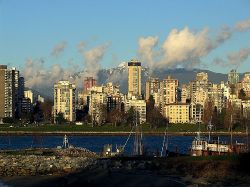
Apartment buildings are multi-story buildings where three or more residences are contained within one structure. Such a building may be called an apartment building, apartment complex, flat complex, block of flats, tower block, high-rise or, occasionally, mansion block (in British English), especially if it consists of many apartments for rent. A high-rise apartment building is commonly referred to as a residential tower, apartment tower, or block of flats in Australia.
High-rise
A high-rise building is defined by its height differently in various jurisdictions. It may be only residential, in which case it might also be called a tower block, or it might include other functions such as hotels, offices, or shops. There is no clear difference between a tower block and a skyscraper. Historically, the term "skyscraper" first referred to buildings with between 10 and 20 stories when these types of buildings began to be constructed in the 1880s. Today, skyscrapers are much taller, and the height criterion has risen to 150 meters (492 feet), while at least half of their floor space has to be habitable.[2] High-rise buildings became possible with the invention of the elevator (lift) and cheaper, more abundant building materials. Their structural system usually is made of reinforced concrete and steel.
Low-rise and mid-rise
Low-rise and mid-rise buildings have fewer stories than high-rise, but the limits are not always clear. Emporis defines a low-rise as "an enclosed structure whose architectural height is below 35 meters, and which is divided at regular intervals into occupiable levels."[3]
Small buildings
In addition to the larger building types with multiple stories, a variety of styles of smaller buildings also serve as apartments.
A "dingbat" is a type of formulaic apartment building that flourished in the Sun Belt region of the United States in the 1950s and 1960s, a vernacular variation of shoebox style "stucco boxes." Dingbats are boxy, two or three-story apartment houses with overhangs sheltering street-front parking.[4] Mainly found in Southern California, but also in Arizona, Florida, Hawaii, Nevada and Vancouver, dingbats are known for their downmarket status and inexpensive rents.
"Duplex" refers to two separate units with a common demising wall or floor-ceiling assembly. The description can be different depending on the part of the US, but generally has two to four dwellings with a door for each and usually two front doors close together but separate. "Duplex" indicates the number of units, not the number of floors, as in some areas of the country they are often only one story. Buildings that have a third story are known as triplexes, or triple-deckers.
In the United States, regional forms have developed, see vernacular architecture. In Milwaukee, a Polish flat or "raised cottage" is an existing small house that has been lifted up to accommodate the creation of a basement floor housing a separate apartment, then set down again, thus becoming a modest pair of dwellings.[5]
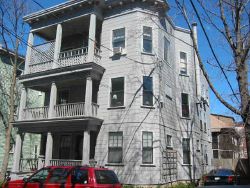
A certain type of three-story apartment building is often called a "three-decker" or "triple-decker" in the United States. These buildings are typical of light-framed, wood construction, where each floor usually consists of a single apartment, and frequently originally extended families lived in two or all three floors. Both stand-alone and semi-detached versions are common.
During the late nineteenth and early twentieth centuries, tens of thousands of triple-deckers were constructed, mostly in New England, as an economical means of housing the thousands of newly-arrived immigrant workers who filled the factories of the area. The economics of the triple-decker are simple: the cost of the land, basement and roof are spread among three or six apartments, which typically have identical floor plans.[6] The triple-decker apartment house was seen as an alternative to the row-housing built in other cities of Northeastern United States during this period, such as in New York City, Boston, Philadelphia, Baltimore, and Washington, D.C.
In the United Kingdom the term duplex is rare. Buildings containing two dwellings with a common vertical wall are instead known as "semi-detached," or colloquially a "semi." This form of construction is very common, and built as such rather than a later conversion.
Types and characteristics
Studio apartment
The smallest self-contained apartments are referred to as studio, efficiency, or bachelor apartments in the US and Canada, or studio flat in the UK. These units usually consist of a large single main room which acts as the living room, dining room, and bedroom combined and usually also includes kitchen facilities, with a separate bathroom.
A variation, sometimes called an "alcove studio," may have a very small separate area; this wing or nook is off the main area, and can be used for dining or sleeping. The apartment's kitchen facilities may be located either in the central room or in a small separate area. The bathroom is usually in its own smaller room, while the toilet can be separated.
A studio apartment differs from a bedsitter in the United Kingdom or single room occupancy (SRO) unit in the United States, in that an SRO does not usually contain a kitchen or bathroom. Bathroom facilities are shared with multiple units on the hall. In the UK, a bedsit, without cooking facilities and with a shared bathroom, is not self-contained and so is not considered an apartment or flat; it forms part of what the UK government calls a House in multiple occupation.[7]
Garden apartment (US)
A garden apartment in American English is defined as "a multiple-unit low-rise dwelling having considerable lawn or garden space."[8] A garden apartment shares some characteristics with a townhouse: Each apartment has its own building entrance, or shares that entrance via a staircase and lobby that adjoins other units immediately above and/or below it. However, unlike a townhouse, each apartment occupies only one level.
Garden apartment buildings are often arranged around courtyards that are open at one end, and the interior grounds are often landscaped. These buildings are almost never more than three stories high, since they typically lack elevators. However, the first "garden apartment" buildings in New York, built in the early 1900s, were constructed five stories high.[9] Some garden apartment buildings place a one-car garage under each apartment.
Garden flat (UK)
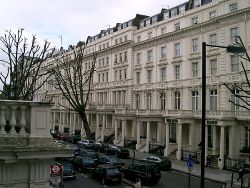
A "garden flat" in British English is defined as "a flat with direct access to a garden: typically, a garden flat consists of basement accommodation in prewar property, but some are in purpose-built blocks in urban areas."[10] The large Georgian or Victorian townhouse was built with an excavated subterranean space around its front known as an area, often surrounded by cast iron railings. This lowest floor housed the kitchen, the main place of work for the servants, with a "tradesman's entrance" via the area stairs. This "lower ground floor," or basement, proved ideal for conversion to self-contained "garden flats." "Garden flat" can serve simply as a euphemism for a basement apartment.
Basement apartment
A "basement apartment" is an apartment located below street level, underneath another structure—usually an apartment building, but possibly a house or a business. Cities in North America are beginning to recognize these units as a vital source of housing in urban areas and legally define them as an Accessory Dwelling Unit or "ADU."
Rent in basement apartments is usually much lower than it is in above-ground units, due to a number of deficiencies common to basement apartments. The apartments are usually cramped, and tend to be noisy, both from uninsulated building noises and from traffic on the adjacent street.[11] They are also particularly vulnerable to burglary, especially those with windows at sidewalk level. In some instances, residential use of below-ground space is illegal, but it is done in order for the building owner to generate extra income. Many renters accept the situation as a way to save money.[11]
Secondary suite
Secondary suites, or "accessory dwelling units" (ADUs), or "in-law apartments," are self-contained apartments, cottages, or small residential units, that are located on a property that has a separate main, single-family home, duplex, or other residential unit. In British English the term "annex" or "granny annex" is used instead.
The "accessory dwelling unit" may be attached to the principal dwelling or an entirely separate unit, located above a garage or in the backyard on the same property.
A secondary suite is considered "secondary" or "accessory" to the primary residence on the parcel. It normally has its own entrance, kitchen, bathroom and living area. There are three types of accessory units: interior, interior with modification, and detached. Examples of these accessory units include:
- A suite above a rear detached garage (a "garage apartment"),
- A suite above the main floor of a single-detached dwelling,
- A suite below the main floor of a single-detached dwelling (a "basement suite").
- A suite attached to a single-detached dwelling at grade, or
- A suite detached from the principal dwelling (a "garden suite" or "guesthouse").
Reasons for wanting to add a secondary suite to a property may be to receive additional income, provide social and personal support to a family member, or obtain greater security.
Loft apartment
Loft apartments developed in North America during the middle of the twentieth century. The term initially described a living space created within a former industrial building, usually nineteenth century. These large apartments found favor with artists and musicians wanting accommodation in large cities, such as New York City.
These loft apartments were usually located in former high rise warehouses and factories left vacant after town planning rules and economic conditions in the mid twentieth century changed. The resulting apartments created a new bohemian lifestyle. They are arranged in a different way from most urban living spaces, often including workshops and art studio spaces. As the supply of old buildings of a suitable nature dried up, developers responded by constructing new buildings in the same aesthetic.
Penthouse
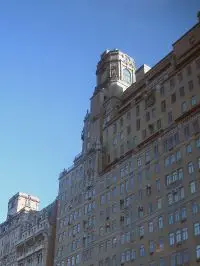
The term "penthouse," derived from the Old French apentis, meaning "attached building" or "appendage" with the modern spelling coming from a sixteenth century folk etymology influence by the French pente ("slope") and English "house,"[12] refers to an apartment or unit on the highest floor of an apartment building, condominium, or hotel. A penthouse apartment/condominium may also provide occupants with private access to the roof space above the apartment. The term "penthouse" originally referred, and sometimes still does refer, to a separate smaller "house" that was constructed on the roof of an apartment building.
Penthouse apartments have not only the advantages of a regular apartment, such as security and convenient location, but also many of those of a house, such as size and design.
Similar to other city apartments, penthouses are usually located in the heart of urban centers yet offer a sense of being situated far away from or above noisy and crowded urban life. Such locations provide easy access to hotels, restaurants, malls, and schools. On the basis of their sometimes larger size, penthouses also generally overcome the issue of small space in regular apartments.
Penthouses are typically differentiated from other apartments by luxurious amenities such as high-end appliances, finest materials fitting, luxurious flooring system, and more. Features not found in the majority of apartments in the building may include a private entrance or elevator, or higher/vaulted ceilings. They may also have such features as a terrace, fireplace, more floor area, oversized windows, multiple master suites, den/office space, hot-tubs, and more. They might be equipped with luxury kitchens featuring stainless steel appliances, granite counter-tops, and breakfast bar/island.
Penthouse residents often have fine views of the city skyline. Access to a penthouse apartment is usually provided by a separate elevator. Residents can also access a number of building services, such as pickup and delivery of dry cleaning, dinner, and more; reservations to restaurants and events made by building staffers; and other concierge services.
Luxury apartment
A "luxury apartment" is a type of apartment that is intended to provide its occupant with higher-than-average levels of comfort, quality and convenience. While the term is often used to describe high-end regular apartments, or even typical apartments as a form of aspirational marketing, a true luxury apartment is one that is variously defined as being in the top ten percent of transactions on the market. However, it can also mean any apartment with extra amenities, such as a doorman, yoga studios or bowling alleys, among others.[13]
Serviced apartment
A "serviced apartment" is any size space for residential living which includes regular maid and cleaning services provided by the rental agent. Serviced apartments or serviced flats developed in the early part of the twentieth century and were briefly fashionable in the 1920s and 1930s. They are intended to combine the best features of luxury and self-contained apartments, often being an adjunct of a hotel. Like guests semi-permanently installed in a luxury hotel, residents could enjoy the additional facilities such as house keeping, laundry, catering, and other services.
A feature of these apartment blocks was quite glamorous interiors with lavish bathrooms but no kitchen or laundry spaces in each flat. This style of living became very fashionable as many upper-class people found they could not afford as many live-in staff after the First World War and reveled in a "lock-up and leave" life style that serviced apartment hotels supplied. Some buildings have been subsequently renovated with standard facilities in each apartment, but serviced apartment hotel complexes continue to be constructed.
Facilities
Apartments may be available for rent furnished, with furniture, or unfurnished into which a tenant moves in with his own furniture.
Laundry facilities may reside in a common area accessible to all building tenants, or each apartment may have its own facilities. Depending on when the building was built and its design, utilities such as heating and electricity may be common for all of the apartments, or separate for each apartment and billed separately to each tenant. Cable television, internet connection, and similar amenities also cost extra. Parking space(s), air conditioning, and extra storage space may or may not be included with an apartment. Rental leases may limit the maximum number of residents in each apartment as well as stating whether pets are permitted and under what conditions.
On or around the ground floor of the apartment building, a series of mailboxes are typically kept in a location accessible to the public and, thus, to the mail carrier. Every unit typically has its own mailbox with individual keys. Some very large apartment buildings with a full-time staff may take mail from the carrier and provide mail-sorting service. Near the mailboxes or some other location accessible by outsiders, a buzzer (equivalent to a doorbell) may be available for each individual unit.
Historical examples
Pre-Columbian Americas
The Puebloan peoples of what is now the Southwestern United States have constructed large, multi-room dwellings, some comprising more than 900 rooms, since the tenth century.
In the Classic Period Mesoamerican city of Teotihuacan,[14] apartments were not only the standard means of housing the city's population of over 200,000 inhabitants, but show a remarkably even wealth distribution for the entire city, even by contemporary standards. Furthermore, the apartments were inhabited by the general populace as a whole, in contrast to other Pre-Modern societies, where apartments were limited to housing the lower class members of the society, as with the somewhat contemporary Roman insulae.[15]
Ancient Rome
In Ancient Rome, the insulae (singular insula) were large apartment buildings where the lower and middle class Romans (the plebs) lived. The floor at ground level was used for tabernas, shops and businesses, with living space on the higher floors. Insulae in Rome and other imperial cities reached up to ten or more stories,[16] some with more than 200 stairs. The lower floors were typically occupied by either shops or wealthy families, while the upper stories were rented out to the lower classes.[16] Surviving Oxyrhynchus Papyri indicate that seven-story buildings even existed in provincial towns, such as in third century Hermopolis in Roman Egypt.[17]
Ancient and medieval Egypt
During the medieval Arabic-Islamic period, the Egyptian capital of Fustat (Old Cairo) housed many high-rise residential buildings, some seven stories tall that could reportedly accommodate hundreds of people. In the tenth century, Al-Muqaddasi described them as resembling minarets,[18] and stated that the majority of Fustat's population lived in these multi-story apartment buildings, each one housing more than 200 people.[19] In the eleventh century, Nasir Khusraw described some of these apartment buildings rising up to fourteen stories, with roof gardens on the top story complete with ox-drawn water wheels for irrigating them.[18]
By the sixteenth century, the current Cairo also had high-rise apartment buildings, where the two lower floors were for commercial and storage purposes and the multiple stories above them were rented out to tenants.[20]
Yemen
High-rise apartment buildings were built in the Yemeni city of Shibam in the sixteenth century, which led to it being called "Manhattan of the desert."[21] The houses of Shibam are all made out of mud bricks, but about 500 of them are tower houses, which rise 5 to 11 stories high, with each floor having one or two apartments.[21] Some of them were over 100 feet (30 m) high, thus being the tallest mudbrick apartment buildings in the world to this day.[22]
Ancient China
The Hakka people in southern China adopted communal living structures designed to be easily defensible, in the form of Weilongwu (围龙屋) and Tulou (土楼). The latter are large, enclosed and fortified earth buildings, between three and five stories high and housing up to eighty families.
Modern examples
England
In the late nineteenth and early twentieth centuries, the concept of the flat was slow to catch on amongst the British middle classes, which generally followed the north European standard of single-family houses dating far back into history. Those who lived in flats were assumed to be lower class and somewhat itinerant, renting for example a "flat above a shop" as part of a lease agreement for a tradesman. In London and most of Britain, everyone who could afford to do so occupied an entire house—even if this was a small terraced house—while the working poor continued to rent rooms in often overcrowded properties, with one (or more) families per room.
During the last quarter of the nineteenth century, as wealth increased, ideas began to change. Both urban growth and the increase in population meant that more imaginative housing concepts would be needed if the middle and upper classes were to continue living in the capital. The traditional London town house was becoming increasingly expensive to maintain. For bachelors and unmarried women in particular, the idea of renting a modern mansion flat became increasingly popular.
In 1972, Oliver's Wharf, a former warehouse on the River Thames in Wapping High Street, Wapping, London was converted into luxury apartments.
By the early twenty-first century, the largest number of residences in London were flats, with over 40 percent of Londoners lived in them.[23] Many of these were built as Georgian or Victorian houses and subsequently divided up. Many others were built as council flats. Many tower blocks were built after the Second World War. A number of these have been demolished and replaced with low-rise buildings or housing estates.
Scotland
Known as "tenements" in Scotland, a term which lacks the pejorative connotations it carries elsewhere and refers simply to any block of flats sharing a common central staircase and lacking an elevator, were very common in the Old Town in Edinburgh from the fifteenth century. They reached ten or eleven stories, and in one case fourteen stories in height. Tenements were, and continue to be, inhabited by a wide range of social classes and income groups.
During the nineteenth century, tenements became the predominant type of new housing in Scotland's industrial cities. Built of sandstone or granite, Scottish tenements are usually three to five stories in height, with two to four flats on each floor. (In contrast, industrial cities in England tended to favor "back-to-back" terraces of brick.) Scottish tenements are constructed in terraces, and each entrance within a block is referred to as a "close" or "stair"—both referring to the shared passageway to the individual flats. Flights of stairs and landings are generally designated common areas, and residents traditionally took turns to sweep clean the floors and, in Aberdeen in particular, took turns to make use of shared laundry facilities in the "back green" (garden or yard). It is now more common for cleaning of the common ways to be contracted out through a managing agent or "factor."
In Glasgow, where Scotland's highest concentration of tenement dwellings can be found, the urban renewal projects of the 1950s, 1960s, and 1970s brought an end to the city's slums, which had primarily consisted of older tenements built in the early nineteenth century in which large extended families would live together in cramped conditions. They were replaced by high-rise blocks that, within a couple of decades, became notorious for crime and poverty. The Glasgow Corporation made many efforts to improve the situation, most successfully with the City Improvement Trust, which cleared the slums of the old town, replacing them with what they thought of as a traditional high street, which remains an imposing townscape. National government help was given following World War I when Housing Acts sought to provide "homes fit for heroes." Garden suburb areas, based on English models, such as Knightswood, were set up. These proved too expensive, so the modern tenement, three stories high, slate roofed, and built of reconstituted stone, was re-introduced.
In 1970 a team from Strathclyde University demonstrated that the old tenements had been basically sound, and could be given new life with re-plumbing providing modern kitchens and bathrooms.[24] The Corporation acted on this in 1973 at the Old Swan Corner, Pollokshaws. Later, privately owned tenements benefited from government help in "stone cleaning", revealing a honey-colored sandstone behind the presumed "grey" tenemental facades. The policy of tenement demolition is now considered to have been short-sighted, wasteful, and largely unsuccessful. Many of Glasgow's worst tenements were refurbished into desirable accommodation in the 1970s and 1980s.[25]
Today, these tenements are bought by a wide range of social types, including young professionals, older retirees, and by absentee landlords, often to rent the apartments to students after they leave halls of residence managed by their institution. Apartments in tenement buildings are highly sought after, due to their locations, often large rooms, high ceilings, ornamentation, and period features.
United States
In the United States, "tenement" is a label usually applied to the less expensive, more basic rental apartment buildings in older sections of large cities. The first New York City tenement was built in 1839, and soon became breeding grounds for outlaws, juvenile delinquents, and organized crime. Many of these apartment buildings are "walk-ups" without an elevator.[26] The Dakota, built in 1884, was one of the first luxury apartment buildings in New York City. The majority, however, remained tenements.
Tenements, or their slum landlords, were also known for their price gouging rent. Many campaigners, such as Upton Sinclair and Jacob Riis, pushed for reforms in tenement dwellings. As a result, the New York State Tenement House Act was passed in 1901 to improve the conditions. In 1949, President Harry S. Truman signed the Housing Act of 1949 to clean slums and reconstruct housing units for the poor.
Some significant developments in architectural design of apartment buildings came out of the 1950s and 1960s. Among them were groundbreaking designs in Chicago, including the 860-880 Lake Shore Drive Apartments (1951), Marina City (1964), and Lake Point Tower (1968).
Canada
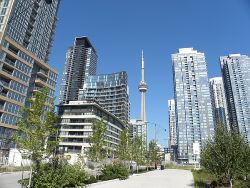
Apartments were popular in Canada, particularly in urban centers like Vancouver, Toronto, Ottawa, Montreal, and Hamilton in the 1950s to 1970s. By the 1980s, many multi-unit buildings were being constructed as condominiums instead of apartments—both are now very common. In Toronto and Vancouver, high-rise apartments and condominiums have been spread around the city, giving even the major suburbs a skyline. The robustness of the condo markets in Toronto and Vancouver are based on the lack of land availability.[27]
Argentina
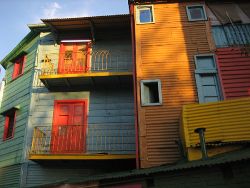
In Buenos Aires the apartments, called conventillos, developed from subdividing one- or two-story houses built around courtyards for well-off families. These were long and narrow, three to six times as long as they were wide, and the size of the patios was reduced until as many as 350 people could be living on a lot that had originally housed 25. Purpose-built apartment buildings copied their form. By 1907 there were some 2,500 conventillos, with 150,000 occupants.[28] El conventillo de la Paloma was particularly famous and is the title of a play by Alberto Vaccarezza.
Australia
In Australia, apartment living is a popular lifestyle choice for yuppies, university students, and more recently empty nesters. However, rising land values in the big cities in recent years has seen an increase in families living in apartments. In Melbourne and Sydney apartment living is not a matter of choice for the many socially disadvantaged people who often end up in public housing towers.
Australia has a relatively recent history in apartment buildings. Terrace houses were the early response to density development, though the majority of Australians lived in fully detached houses. Apartments of any kind were legislated against in the Parliament of Queensland as part of the Undue Subdivision of Land Prevention Act 1885.
The earliest apartment buildings were in the major cities of Sydney and Melbourne as the response to fast rising land values–both cities are home to the two oldest surviving apartment buildings in the country, Kingsclere in Potts Point, and The Canterbury Flats in St Kilda. Melbourne Mansions on Collins Street, Melbourne (now demolished), built in 1906 for mostly wealthy residents is believed by many to be the earliest. Today the oldest surviving self-contained apartment buildings are in the St Kilda area including the Fawkner Mansions (1910), Majestic Mansions (1912 as a boarding house) and the Canterbury (1914—the oldest surviving buildings contained flats).[29] Kingsclere, built in 1912 is believed to be the earliest apartment building in Sydney and still survives.[30]
During the interwar years, apartment building continued in inner Melbourne (particularly in areas such as St Kilda and South Yarra), Sydney (particularly in areas such as Potts Point, Darlinghust and Kings Cross) and in Brisbane (in areas such as New Farm, Fortitude Valley and Spring Hill).
Post-World War II, with the Australian Dream apartment buildings went out of vogue and flats were seen as accommodation only for the poor. Walk-up flats of two to three stories, however, were common in the middle suburbs of cities for lower income groups.
The main exceptions were Sydney and the Gold Coast, Queensland where apartment development continued for more than half a century. In Sydney a limited geography and highly sought after waterfront views (Sydney Harbour and beaches such as Bondi) made apartment living socially acceptable. While on the Gold Coast views of the ocean, proximity to the beach and a large tourist population made apartments a popular choice. Since the 1960s, these cities maintained much higher population densities than the rest of Australia through the acceptance of apartment buildings.
In other cities, apartment building was almost solely restricted to public housing. Public housing in Australia was common in the larger cities, particularly in Melbourne (by the Housing Commission of Victoria) where a huge number of hi-rise housing commission flats were built between the 1950s and 1970s by successive governments as part of an urban renewal program. Areas affected included Fitzroy, Flemington, Collingwood, Carlton, Richmond and Prahran. Similar projects were run in Sydney's lower socio-economic areas like Redfern.
In the 1980s, modern apartment buildings sprang up in riverside locations in Brisbane (along the Brisbane River) and Perth (along the Swan River).
In Melbourne, in the 1990s, a trend began for apartment buildings without the requirement of spectacular views. As a continuation of the gentrification of the inner city, a fashion became New York "loft" style apartments (see above) and a large stock of old warehouses and old abandoned office buildings in and around the central business district became the target of developers. The trend of adaptive reuse extended to conversion of old churches and schools. Similar warehouse conversions and gentrification began in Brisbane suburbs such as Teneriffe, Queensland and Fortitude Valley and in Sydney in areas such as Ultimo. As supply of buildings for conversion ran out, reproduction and post modern style apartments followed. The popularity of these apartments also stimulated a boom in the construction of new hi-rise apartment buildings in inner cities. This was particularly the case in Melbourne which was fueled by official planning policies (Postcode 3000), making the CBD the fastest growing, population wise in the country. Apartment building in the Melbourne metropolitan area has also escalated with the advent of the Melbourne 2030 planning policy. Urban renewal areas like Docklands, Southbank, St Kilda Road and Port Melbourne are now predominantly apartments. There has also been a sharp increase in the number of student apartment buildings in areas such as Carlton in Melbourne.
Despite their size, other smaller cities including Canberra, Darwin, Townsville, Cairns, Newcastle, Wollongong, Adelaide and Geelong began building apartments in the 2000s.
Today, residential buildings Eureka Tower and Q1 are the tallest in the country. In many cases, apartments in inner city areas of the major cities can cost much more than much larger houses in the outer suburbs. Some Australian cities, such as Gold Coast, Queensland, are inhabited predominantly by apartment dwellers.
Greece
The term πολυκατοικία (polykatoikia, literally "multiresidence") is used in Greek to denote every apartment building. One of the first, if not the first, apartment buildings in Athens was built in 1918–1919 by architect Alexandros Metaxas in an eclectic style for Petros Giannaros on Philellinon and Othonos Streets, adjacently to Syntagma Square. Thanks to the fact that this building was one of the first ones to be built with reinforced concrete, it was unexpectedly, as well as asymmetrically higher than the adjacent ones.
The changes that took place in Greek society after the defeat of Greece during the Greco-Turkish War of 1919–1922, and the ensuing population exchange between Greece and Turkey created different housing needs for the population, revealed how important the construction sector could be for the Greek economy.
In 1929, two important laws concerning apartment buildings took effect. The law about "horizontal property" (οριζόντια ιδιοκτησία) made it possible that many different owners own one apartment building, each by owning one or more apartment units. Theoretically, each apartment corresponds to a percentage of the original plot. The most important effect of this law was the practice of "αντιπαροχή" (antiparochì, literally "a supply in exchange") which allowed the owner of a plot to make a contract with a construction company who would build the apartment building with ownership of the apartments divided between them. Although during the interwar period the practice of antiparochì was limited, as the construction of most apartment buildings was financed solely by the original owners of the plot, antiparochì became the most common method for financing the construction of condominiums (polykatoikìes) from the 1950s onward.
Later in 1929 came into effect the first General Building Regulation. Most importantly, not only did it regulate the height and surface area of the buildings, but it also introduced innovations that their use came to characterize the modern style of the buildings of the era, such as the bay windows, or erkers (έρκερ), as they are known in Greek after the German term.
Russia
"Communal apartments" (singular: Russian: коммунальная квартира, kommunal'naya kvartira, slang. kommunalka) appeared in the Soviet Union following the Russian revolution of 1917. The concept of communal apartments grew in Russia and the Soviet Union as a response to a housing crisis in urban areas; authorities presented them as the product of the “new collective vision of the future.” Between two and seven families typically shared a communal apartment. Each family had its own room, which often served as a living room, dining room, and bedroom for the entire family. All the residents of the entire apartment shared the use of the hallways, kitchen (commonly known as the "communal kitchen"), bathroom and telephone (if any).[31] The communal apartment became the predominant form of housing in the USSR for generations, and examples still exist in the central districts of large Russian cities.[32]
Yugoslavia
The development of residential architecture in Yugoslavia during the period of socialism had its peak in the 1960s and 1970s. Significant progress in construction was accompanied by housing research directed towards finding the optimal urbanistic solutions for the newly formed lifestyle of the socialist society. The tendency was to "pack" as many residential units as possible into each building, almost up to the limits of the functional minimum, at the same time with the aim of setting a more humane pattern of living.[33] As a consequence of these aspirations, the following apartment designs emerged: (a) apartments with an extended circulation area, (b) apartments with a central sanitary core, (c) apartments with a circular connection and (d) apartments with extended perspectives ("an enfilade”).[34]
The process of humanizing housing was not characteristic only in the Yugoslav context; similar ideas also appeared in other socialist countries of that period. Examples of similar pre-fabricated housing construction exist in in the Soviet Union (Khrushchyovka), Czechoslovakia (Panelák), Hungary (Panelház), and East Germany (Plattenbau).
Notes
- ↑ Long Leases (Scotland) Act 2012 UK Legislation. Retrieved June 14, 2021.
- ↑ Fred Mills, What makes a building a skyscraper? The answer is more complicated than you might imagine The B1M, July 20, 2020. Retrieved June 15, 2021.
- ↑ low-rise building (ESN 49213) Emporis Standards. Retrieved June 15, 2021.
- ↑ Leonard Pitt and Dale Pitt, Los Angeles A to Z: An Encyclopedia of the City and County (University of California Press, 2000, ISBN 978-0520205307).
- ↑ Sally McMurry and Annmarie Adams (eds.), People, Power, Places (University of Tennessee Press, 2000, ISBN 978-1572330757).
- ↑ Bruce Irving, The Jamaica Plain House This Old House. Retrieved June 16, 2021.
- ↑ Private renting: Houses in multiple occupation GOV.UK. Retrieved June 14, 2021.
- ↑ Garden apartment Merriam-Webster Dictionary. Retrieved June 15, 2021.
- ↑ Barry Popik,Garden Apartment April 4, 2005. Retrieved June 15, 2021.
- ↑ Garden Flat Dictionary.com. Retrieved June 15, 2021.
- ↑ 11.0 11.1 David W. Chen, Be It Ever So Low, the Basement Is Often Home The New York Times, February 25, 2004. Retrieved June 15, 2021.
- ↑ penthouse Etymology online. Retrieved June 16, 2021.
- ↑ Beth Stebner, What does luxury real estate mean when everything is called "luxury"? Brick Underground, August 20, 2015. Retrieved June 16, 2021.
- ↑ Owen Jarus, Teotihuacan: Ancient City of Pyramids Live Science, August 20, 2012. Retrieved June 16, 2021.
- ↑ Michael E. Smith, Living the good life in Teotihuacan Wide Urban World, October 22, 2014. Retrieved June 16, 2021.
- ↑ 16.0 16.1 Gregory S. Aldrete, Daily Life in the Roman City: Rome, Pompeii and Ostia (University of Oklahoma Press, 2009, ISBN 978-0806140278).
- ↑ Katja Lembke, Cäcilia Fluck, and Günter Vittmann, Ägyptens späte Blüte: Die Römer am Nil (Mainz, 2004, ISBN 978-3805332767).
- ↑ 18.0 18.1 Doris Behrens-Abouseif, Islamic Architecture in Cairo (American University in Cairo Press, 1993, ISBN 978-9774242038).
- ↑ James E. Lindsay, Daily Life in the Medieval Islamic World (Hackett Publishing Company, Inc., 2008, ISBN 978-0872209343).
- ↑ Hisham Mortada, Traditional Islamic Principles of Built Environment (Routledge, 2011, ISBN 978-0415515061).
- ↑ 21.0 21.1 Old Walled City of Shibam UNESCO World Heritage Centre. Retrieved June 16, 2021.
- ↑ J.G.T. Shipman, The Hadhramaut Asian Affairs 15(2) (June 1984):154–162. Retrieved June 16, 2021.
- ↑ Joanne Atkin, What type of housing do people live in? Mortgage Finance Gazette, August 11, 2017. Retrieved June 16, 2021.
- ↑ Elizabeth Williamson, Anne Riches, and Malcom Higgs, Glasgow (Pevsner Architectural Guides: Buildings of Scotland) (Yale University Press, 1990, ISBN 978-0300096743).
- ↑ Demolition of tenements in Gourlay Street, 1975 Glasgow Digital Library. Retrieved June 17, 2021.
- ↑ {What is a Walk-Up Apartment and Why You Should Rent One alpaca, November 19, 2020. Retrieved June 17, 2021.
- ↑ Sissi Wang, The latest threat to the condo market: apartment buildings rise again Canadian Business, July 8, 2015. Retrieved June 17, 2021.
- ↑ Mark Girouard, Cities and People: A Social and Architectural History (Yale University Press, 1987, ISBN 978-0300039689).
- ↑ Richard Peterson, The Canterbury (Flats) - 236 Canterbury Road, St Kilda West A Place of Sensuous Resort: Buildings of St Kilda and Their People (St Kilda Historical Society, 2005). Retrieved June 17, 2021.
- ↑ High Rise has a past too Understanding Heritage. Retrieved June 17, 2021.
- ↑ Adele Barker and Bruce Grant, The Russia Reader: History, Culture, Politics (Durham: Duke University Press, 2010, 978-0822346487), 615.
- ↑ Ilya Utekhin, Alice Nahkimovsky, Slava Paperno, and Nancy Ries, The World of the Soviet Citizen: Communal apartments Communal Living in Russia: A Virtual Museum of Soviet Everyday Life.
- ↑ Vladimir Lojanica, Jelena Ristić, and Verica Međo, Multi–family Housing Architecture in Belgrade: Models and Development International Scientific Journal Architecture and Engineering (2011) Retrieved June 17, 2021.
- ↑ Đorđe Alfirević and Sanja Simonović Alfirević, Th 'Socialist Apartment' in Yugoslavia: Paradigm or Tendency? Spatium 40 (2018): 8-17. Retrieved June 17, 2021.
ReferencesISBN links support NWE through referral fees
- Aldrete, Gregory S. Daily Life in the Roman City: Rome, Pompeii and Ostia. University of Oklahoma Press, 2009. ISBN 978-0806140278
- Allpern, Andrew. The Dakota: A History of the World's Best-Known Apartment Building. Princeton Architectural Press, 2015. ISBN 978-1616894375
- Barker, Adele Marie, and Bruce Grant (eds.). The Russia Reader: History, Culture, Politics. Duke University Press Books, 2010. ISBN 978-0822346487
- Behrens-Abouseif, Doris. Islamic Architecture in Cairo. American University in Cairo Press, 1993. ISBN 978-9774242038
- Cliff, Stafford. 2007. The Way We Live In the City. Rizzoli. ISBN 978-0847829644
- Condaratos, Savas, and Wilfried Wang (eds.). Greece: 20th-Century Architecture. Prestel Pub., 1999. ISBN 978-3791321523
- Girouard, Mark. Cities and People: A Social and Architectural History. Yale University Press, 1987. ISBN 978-0300039689
- Lembke, Katja, Cäcilia Fluck, and Günter Vittmann. Ägyptens späte Blüte: Die Römer am Nil. Mainz, 2004. ISBN 978-3805332767
- Lindsay, James E. Daily Life in the Medieval Islamic World. Hackett Publishing Company, Inc., 2008. ISBN 978-0872209343
- McMurry, Sally, and Annmarie Adams (eds.). People, Power, Places. University of Tennessee Press, 2000. ISBN 978-1572330757
- Mortada, Hisham. Traditional Islamic Principles of Built Environment. Routledge, 2011, ISBN 978-0415515061
- Pitt, Leonard, and Dale Pitt. Los Angeles A to Z: An Encyclopedia of the City and County. University of California Press, 2000. ISBN 978-0520205307
- Williamson, Elizabeth, Anne Riches, and Malcom Higgs. Glasgow (Pevsner Architectural Guides: Buildings of Scotland). Yale University Press, 1990. ISBN 978-0300096743
- Zukin, Sharon. Loft Living: Culture and Capital in Urban Change. Rutgers University Press, 2014. ISBN 978-0813570976
Credits
New World Encyclopedia writers and editors rewrote and completed the Wikipedia article in accordance with New World Encyclopedia standards. This article abides by terms of the Creative Commons CC-by-sa 3.0 License (CC-by-sa), which may be used and disseminated with proper attribution. Credit is due under the terms of this license that can reference both the New World Encyclopedia contributors and the selfless volunteer contributors of the Wikimedia Foundation. To cite this article click here for a list of acceptable citing formats.The history of earlier contributions by wikipedians is accessible to researchers here:
- Apartment history
- Modern_architecture_in_Athens history
- Basement_apartment history
- Studio_apartment history
- Penthouse_apartment history
- Communal_apartment history
- Luxury_apartment history
The history of this article since it was imported to New World Encyclopedia:
Note: Some restrictions may apply to use of individual images which are separately licensed.
